FRASER (or FRAZER), ALEXANDER V. (1804-1868). Commander, United States Revenue Marine Bureau (forerunner of the United States Coast Guard). Fraser, a New Yorker by birth, attended the Mathematical, Nautical and Commercial School in New York City, went to sea as a mate, and was commissioned a second lieutenant in the Revenue Cutter Service by President Andrew Jackson in 1832. Serving aboard the Alert, he was in Charleston Harbor during the Nullification Crisis. He received a leave of absence in 1836 when he commanded the Himmaleh to Japan, China, and Malaysia to take advantage of the lucrative trade there. After two years, he asked to return to the Revenue Service and was commissioned first lieutenant by President Van Buren and returned to the Alert. He then applied for and received a new position with the Cutter Service from 1838-1841, helping vessels in distress in New York Harbor.
Civil War Bio Search
After a promotion to captain 1842, he was given command of the Ewing and then was put in charge of the new Revenue Marine Bureau. From 1844 to 1848, Fraser overhauled the service, ordering the first steam-propelled cutters, instituting a merit system of promotion and abolishing flogging and the employment of slaves. He also prohibited liquor aboard all ships. On November 1, 1848, Fraser was put in command of the new Customs Service sailing cutter C.W. Lawrence. On November 18 of that year, he set sail from Washington, D.C, to the Pacific Coast with orders to take part in the Coast Survey of the newly acquired territories of Oregon and California, aid merchant ships in distress and collect customs duties. Delayed by a series of squalls which damaged the ship, and by the inexperience of the junior officers, some of whom had never been to sea, the Lawrence put in to Rio de Janeiro on January 19, 1849, for repairs that took two months. On June 20, he reached Valparaiso, Chile, after having spent three months rounding Cape Horn in heavy seas, and received news that gold had been discovered in California. After a detour to the Sandwich Islands he arrived at San Francisco on October 31, 1849, to find hundreds of vessels in the harbor, lawlessness and violence, and no effective civil authority. The executive officer and his subordinate deserted, leaving Fraser and one officer to enforce the revenue laws and aid in suppressing mutinies, which they did with courage and great devotion to duty.
Fraser returned to New York in 1852. Although he was temporarily suspended and charged with administering capital punishment in California, no charges could be proved and he returned to captaining New York Harbor. In 1856, it was determined that a new cutter was needed and eventually, Congress appropriated money for the Harriet Lane, a cutter introduced in 1857 that later saw service in the Civil War when it was transferred in 1861 to the Navy. Because of in-fighting at the Department of the Treasury by the assistant secretary who opposed the Harriet Lane, Fraser was removed from his position and retired to private business as a marine insurance agent. His efforts to be reinstated in 1861 and serve in the Civil War were unsuccessful. He was a member of the Holland Masonic Lodge No. 8. In 1944, a Liberty Ship was named after him. He last lived at 377 State Street, Brooklyn. Section 162, lot 14467.

FRASER, JAMES LESLIE (1825-1866). Colonel, 47th New York Infantry. Born in Ireland, James Leslie Fraser enlisted for three years on May 16, 1861, mustered into the 47th New York Infantry as its lieutenant colonel with rank from September 14, and officially commissioned on December 4. He was promoted to colonel on September 3, 1862, with rank from August 5, 1862. Fraser served with the 10th Army Corps, Department of the South, at Hilton Head, South Carolina, in October 1862, when he was appointed port commandant for Port Royal, and was discharged for disability six months later, suffering from liver problems and diabetes. Following the War, Fraser owned a restaurant in New York City. He was shot and killed there during a fight on July 7, 1866. Section 180, lot 13152.

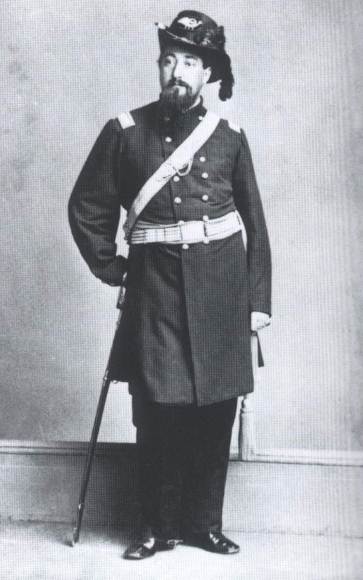
FRASER (or FRAZER), JOHN (1827-1884). Private, 69th New York Infantry, Company G. Fraser’s gravestone is inscribed with a birthplace of Glasgow, Scotland. During the Civil War, he enlisted as a private at New York City on January 26, 1864, and mustered immediately into Company G of the 69th New York Infantry. As per his muster roll, he was a shirt-cutter who was 5′ 8″ tall with blue eyes, brown hair and a sandy complexion. Fraser was taken as a prisoner of war at the Battle of the Wilderness, Virginia, on May 5, 1864. He was absent when his company mustered out on June 30, 1865, at Alexandria, Virginia.
As per Fraser’s death certificate, he was married and a general merchant. An article on his death in the New York Sun reports that his body was found in a cellarway in front of a produce store at 650 Hudson Street in Manhattan. His papers, found on his body, noted that he lived in Liverpool, England, had arrived in New York two days earlier on the Arizona, and was a dealer in woodenware who frequently traveled to the United States on business. His jewelry, money and eyeglasses were found on his person; James Frazer, his nephew, was identified as a pottery dealer in Manhattan. His death was attributed to heart disease. Section 14, lot 4969.
FRASER, ROBERT (1829-1866). Private, 84th New York (14th Brooklyn) Infantry, Company D. A Brooklyn native, Fraser enlisted as a private on April 18, 1861, and mustered into Company D of the 14th Brooklyn on May 23. As per his muster roll, he was an assistant water surveyor at the time of his enrollment. His muster roll also notes that he was detached to the Ambulance Corps in September 1862 and that he was absent and hospitalized in Washington, D.C., in April 1864. He mustered out with the company on June 6, 1864, at New York City. As per his obituary in the Brooklyn Daily Eagle, he died from consumption which he contracted in the service. Members of Hook & Ladder Company #5 and officers and members of the 14th Brooklyn were invited to his funeral. He last lived at 195 Myrtle Avenue in Brooklyn. Section 115, lot 13536 (Soldiers’ Lot), grave 105.
FREEBORN, THOMAS (1808-1846). New York ship pilot and namesake of Civil War steamboat. Freeborn was the harbor pilot on the sailing vessel John Minturn, which ran aground near Monmouth County, New Jersey, during the Great Northeast Snowstorm of 1846. Freeborn gave his coat to the captain’s freezing wife who was with her children. After a full day in the fierce snowstorm with no chance of rescue, the ship broke apart and most of its passengers were thrown into the icy sea; Freeborn froze to death. The captain, his wife and children were also among the ship’s 42 fatalities. The Pilots of New York erected the Pilot’s Monument in the Freeborn family’s plot in Green-Wood Cemetery to honor Thomas Freeborn’s memory and self-sacrifice. The monument is emblazoned with nautical designs and atop rests the figure of Hope. The accident initiated a cry for a life-saving coastal service.
During the Civil War, a side-wheel steamboat, the Thomas Freeborn, was chartered by the United States Navy in May 1861. She fought at Hampton Roads, Virginia, assisted in the occupation of Alexandria, Virginia and was engaged at the Battle of Aquia Creek. As part of the Potomac Flotilla, the Thomas Freeborn was in service throughout the War and took part in the search for John Wilkes Booth. Thomas’s brother, William Freeborn, was well known in New York City as the president of the New York Floating Dry-Dock Company and the head of a successful copper company that bore his name. His nephew, also Thomas Freeborn (see), was a lawyer who served in the Civil War as a private with the 7th Regiment and as a captain in the 1st Mounted New York Rifles. Thomas is buried in the Freeman family plot at Green-Wood. It is visible from New York Harbor—as a lesson to harbor pilots to take care. Section 111, lot 12218.
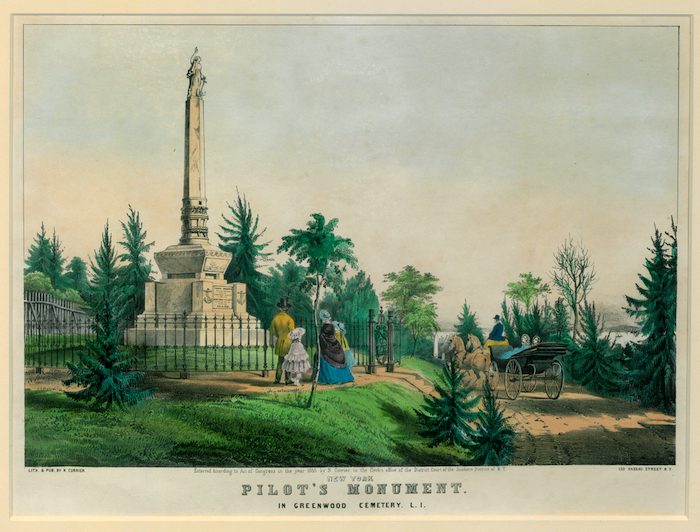
FREEBORN, THOMAS (1842-1886). Captain, 1st New York Mounted Rifles, Companies M, D, and B; private, 7th Regiment, New York State National Guard, Company K. A native New Yorker, Thomas’s father, William Freeborn, was well-known in New York City as the president of the New-York Floating Dry-Dock Company and the head of a successful copper company that bore his name. His uncle, Thomas Freeborn (see), was a pilot onboard the John Minturn, an ill-fated ship destined to New York from New Orleans that ran aground at Mantoloking, New Jersey, during a northeaster on February 14, 1846.
During the Civil War, Thomas Freeborn (son of William and nephew of Thomas) enlisted at New York City as a private on May 25, 1862, mustered immediately into the 7th Regiment, and mustered out at New York City after three months of service on September 5. As per his muster roll, he was a student who was 5′ 10″ tall with gray eyes, light hair and a fair complexion. Five days later, he re-enlisted as a second lieutenant at New York City and was immediately commissioned into Company M of the 1st Mounted Rifles. Rising through the ranks, he was promoted to first lieutenant on November 7, 1862, effective upon his transfer to Company D on November 24, and then became captain on March 15, 1863, effective upon his transfer to Company B on May 11. He was with General Butler in Virginia at Bermuda Hundred and fought in the cavalry attack on Petersburg. Freeborn commanded the 1st Mounted Rifles escorting General Foster at Deep Bottom, Virginia, from July 26-29, 1864, and escorting General Burney at the Battle of Strawberry Fields, Virginia, from August 14-18, 1864. He was cited for gallantry at Fort Harrison, Virginia, where the regiment was dismounted and held an advanced position. Freeborn was also at Drewry’s Bluff, Virginia, and at Weldon Railroad, Virginia. The 1st Mounted Rifles took part in over 50 battles and skirmishes but sustained no severe losses. He resigned on April 28, 1865.
The New York City Directory of 1868 states that he was a merchant. The census of 1880 and the New York City Directory for 1882 indicate that he was a lawyer. Two of his post-war positions were as president of the New York Floating Dry Dock Company and president of the Freeborn Copper Company; the years in which he held those jobs are not known. As per his obituary in the New York Herald, veterans of the 7th Regiment were requested to attend his funeral. His last residence was in Hempstead, Long Island. Acute meningitis was listed as the cause of his death. In 2019, a letter signed by Freeborn accepting an offer to dine with members of the 7th Regiment’s Engineering Corps, hosted by a prominent banker, Georges Jaques, and payment of a $10 subscription fee was offered for sale on eBay. Section 111, lot 12218.

FREEMAN, HENRY C. (1843-1923). Musician, 65th New York Infantry, Company A. Freeman, a native of New York City, enlisted there as a musician on July 1, 1861, mustered into the 65th New York on that date, and was discharged for disability on December 21 at Washington, D.C. At some point in his service, he was reduced to the rank of private.
In civilian life, Freeman was a clerk/stenographer in the chief engineer’s office of the Department of Docks in Manhattan. In addition, he was a member of Ulysses S. Grant Post #327 of the G.A.R. He applied for and was granted an invalid pension in 1890, certificate 640,087. The Veterans Schedule of 1890 confirms his Civil War service. He last resided at 1529 East 19th Street in Brooklyn. He died of arteriosclerosis. Melissa Freeman applied for and received a widow’s pension in 1923, certificate 929,625. Section 18, lot 6710.
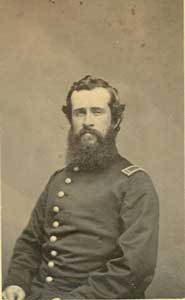
FREEMAN (or FREMAN), JOHN N. (1831-1888). Surgeon, 106th New York Infantry; assistant surgeon, 5th New York Infantry; 8th New York Heavy Artillery. Dr. Freeman, who was born in LaGrange, Ohio, attended the Normal Institute at Norwalk, Ohio, and taught school while pursuing his medical studies. A graduate of the Medical Department of the University of the City of New York in 1857, he practiced medicine in Morris, Illinois, and studied in London, England, in 1861.
Freeman enlisted on August 21, 1862, at Falmouth, Virginia, as an assistant surgeon, and was commissioned into the Field and Staff of the 5th New York (also known as Duryée’s Zouaves) the next month on September 9. After being detached to Division Hospital on December 21, 1862, he rejoined the 5th in April 1863, was appointed inspector of the 5th Corps hospitals on April 30, and mustered out at New York City on May 14, 1863. He re-enlisted as an assistant surgeon on July 1, 1863, at Baltimore, Maryland, was commissioned into the Field and Staff of the 8th New York Heavy Artillery, and was discharged for promotion to surgeon on February 23, 1864. The next day, he was commissioned into the 106th’s Field and Staff where he served until he mustered out at Washington, D.C., on June 22, 1865. Freeman participated in these Virginia battles: Second Bull Run, Fredericksburg, Spotsylvania, and the siege and capture of Petersburg, among others.
After the War, he returned to Morris, Illinois, where he served as coroner and Health Commissioner until 1869 when he came to Brooklyn. In addition to his medical practice, he was a visiting surgeon at St. John’s Hospital in Brooklyn. In 1884, he joined the Ulysses S. Grant Post #327 of the G.A.R. He last resided at 80 Hanson Place in Brooklyn but died of cholera while vacationing in Omaha, Nebraska. Section 148, lot 22465.
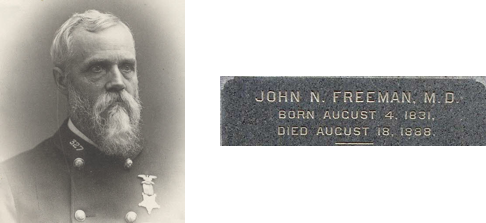
FRENCH, JAMES (1835-1919). Principal musician, 5th New York Veteran Infantry, Company A. Born in Cork, Ireland, French enlisted as a bugler on August 6, 1863, at New York City, and mustered into Company A of the 5th New York Veterans. As per his muster roll, he was a musician who was 5′ 6½” tall with blue eyes, brown hair and a light complexion. On July 6, 1864, he was promoted to the rank of principal musician and was transferred into the Field and Staff on that day. On March 25, 1865, he was reported as absent and sick, and was listed as a patient at Carver U.S. General Hospital as of April 18, 1865. Although his soldier record notes that he deserted from Stanton Hospital at Washington, D.C., on July 21, 1865, that might not be accurate because he had been transferred to Stanton Hospital on July 17, 1865. It is possible that the regiment lost track of his whereabouts and listed him as a deserter in error.
As per the censuses of 1870 and 1880, French was a bookkeeper. The census of 1900 indicates he was an insurance clerk; as of 1910, he worked in a clerical office. The New York City census of 1915 lists him as manager of an estate. His last residence was on Lewis Avenue in Brooklyn. A concussion caused his death. Section 164, lot 15024.

FRENCH, WILLIAM H. (1845-1931). Unknown rank, Union Army; landsman, United States Navy. A native of New York City, French served in the Army and Navy during the Civil War. As per his pension record, he was a landsman in the United States Navy from September 15, 1863, through July 26, 1865. He served aboard the USS Sonoma, USS Vermont, USS North Carolina and USS New Hampshire. Information about his service in the Army is confined to his obituaries.
A man of many trades, French was a truckman according to the censuses of 1870 and 1880 and worked at a livery stable as per the census of 1900. His obituary in the Brooklyn Daily Eagle, which confirmed his Civil War service in the Army and Navy, noted that he served at the Battle of Gettysburg, Pennsylvania. His service at Gettysburg is also confirmed in the obituary for his son, Frank T. French, in the Brooklyn Standard Union on September 13, 1928. That obituary noted that the deceased’s father, “Captain French,” had an assortment of medals and citations for his Civil War service including a medal for gallantry at Gettysburg.
William French also had a citation for services to the State Department in Paris for his work there during World War I. At the inception of World War I, he was in Europe where his son was an executive for Standard Oil at its office in Paris. According to the census of 1910 and his passport applications of 1915 and 1919, he was a real estate broker. At that time, he was 5′ 10″ tall with brown eyes, dark brown hair, large mouth, high forehead and round chin. He was still working as an insurance broker according to the censuses of 1920 and 1930.
Always interested in military affairs, French was an active member of Winchester Post #197 of the G.A.R.; his chapter held a memorial service for him. In addition, he was an honorary member of the veterans’ post of the Spanish-American War and World War I. A horseback rider, he rode every year in the Decoration Day parade until the last year of his life when he sat in the grandstand. In 1888, he received a pension from the Navy, certificate 3,663; his monthly payment was increased to $100 in 1931. He last lived at 833 41st Street in Brooklyn. He died of cancer. Fannie French, who is interred with him, applied for and received a widow’s pension shortly after his death, certificate a-1-20-32. Section 73, lot 4286.
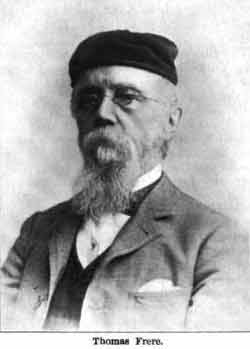
FRÈRE (or FRINE), THOMAS (1820-1900). Private, 13th Regiment, New York State National Guard, Company G. A native of New York City, Frère joined the 13th National Guard in 1845. Most notably, he was a renowned amateur chess player who organized the First American Chess Congress in 1857 in which he played in the minor tournament and introduced the world to Paul Morphy, a chess prodigy, who won the competition. He wrote and compiled Frère’s Chess Handbook in 1858 and Morphy’s Games of Chess. In addition, Frère organized the Brooklyn and Manhattan Chess Clubs and served as secretary of the Brooklyn Chess Club in the 1850s.
During the Civil War, Frère enlisted at New York City as a private in 1863, served with the 13th Regiment for 30 days, and mustered out at the expiration of his enlistment. The regiment saw action at Fort Washington, Pennsylvania, on July 2, 1863. It appears that his last name was garbled in the muster roll to “Frine.” In a 1946 newspaper article, his daughter, Mary Louise Frère Brown, who turned 100, remembered the day her father returned from the Civil War. A pass that his daughter kept was issued to Private Frère by the lieutenant commanding Company G of the 13th New York National Guard in July 1863.
Frère played a major role in the Fifth and Sixth American Chess Congresses in 1880 and 1889 serving on the executive committee of the former event. As per his obituaries in the Brooklyn Standard Union and the Brooklyn Daily Eagle, he worked as a clerk for thirty-five years for the Equitable Insurance Company of New York, retiring at half-pay in 1885. At the time of his death, he was the oldest surviving member of the 13th National Guard. He last lived on 67th Street and Fifth Avenue in Brooklyn. His death was attributed to bronchitis. Section 165, lot 16932, grave 3.
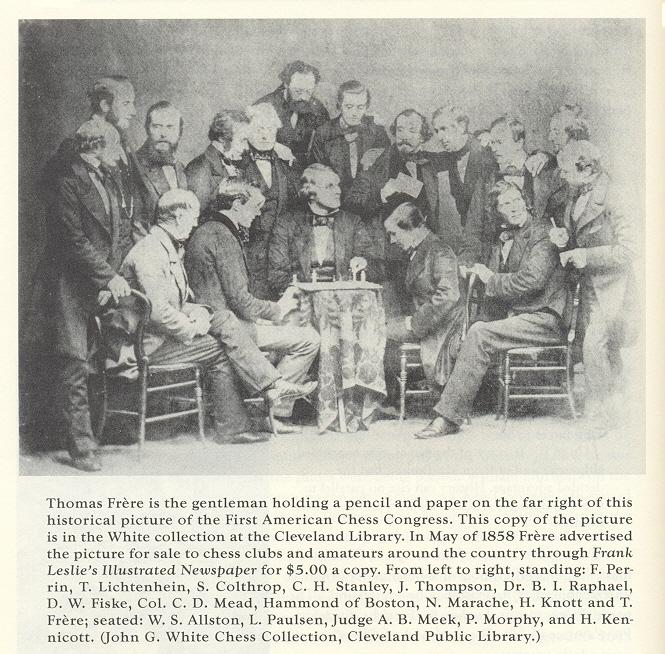
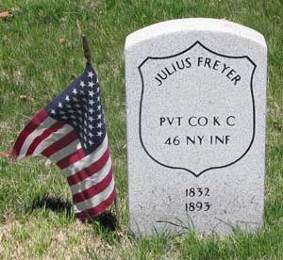
FREYER, JULIUS (1832-1893). Private, 46th New York Infantry, Companies K and C. A German native, Freyer enlisted on September 16, 1861, at New York City, and mustered into Company K of the 46th New York. He had an intra-regimental transfer to Company C on October 31, 1861, and deserted on June 8, 1863, at Cincinnati, Ohio. As per the 1865 Brooklyn Directory and the 1870 census, he was a cabinetmaker. On October 15, 1868, Freyer filed an application for United States citizenship. The 1880 census and the 1892 New York State census indicate that he was still working as a cabinetmaker. He last lived at 258 Union Street in Brooklyn. He succumbed to heart disease. Section 115, lot 4196, grave 812.

FRICKE, WILLIAM HENRY (1840-1918). Corporal, 76th Pennsylvania Infantry, Company D; private, 196th Pennsylvania Infantry, Company H. Of German birth, Fricke immigrated to the United States when he was nineteen. During the Civil War, he enlisted as a private on July 14, 1864, mustered into the 196th Pennsylvania the same day, and mustered out after 100 days on November 17, 1864, at Philadelphia, Pennsylvania. On February 18, 1865, he re-enlisted as a private, mustered into the 76th Pennsylvania, and was promoted to corporal on July 1 shortly before he mustered out on July 18, 1865, at Raleigh, North Carolina.
The 1892 Brooklyn census notes that Fricke was a furrier; his shop was at 65 Lafayette Street. In 1904, he successfully applied for a pension, certificate 1,113,914. His pension application notes that he used the alias of Charles Meyer. Fricke was a member of Gouverneur K. Warren Post #286 of the G.A.R. The census of 1910 reports that he was a furrier by trade. As per his obituary in the Daily Standard Union, which confirmed his Civil War service, he was a member of the 13th Regiment, New York State Militia, Company D, for 27 years. His last residence was 448 Nostrand Avenue in Brooklyn. The cause of his death was senility. Section 127, lot 3611, grave 145.
FRIEDRICH, GEORGE (1828-1885). Private, 5th Regiment, New York State Militia, Company F. A German by birth, Friedrich enlisted as a private at Washington, D.C, on May 16, 1861, the same day that he mustered into the 5th Regiment, and was discharged after three months on August 7. His pension record indicates that he subsequently served for another 30 days with the regiment. His last residence was 222 West 36th Street, Manhattan. In 1891, his widow was awarded a pension, certificate 335,670. Section 15, lot 17263, grave 1019.
FRIEL, DANIEL G. E. (1831-1880). Corporal, 15th New York Engineers, Companies G and D. A New York City native, Friel enlisted as a private on May 9, 1861, at New York City, and mustered into Company G of the New York 15th Engineers on June 17. As per his muster roll, he was a clerk who was 5′ 5″ tall with blue eyes, brown hair and a light complexion. He mustered out two years later on June 25, 1863. Friel re-enlisted two months later on August 31, mustered into Company D of the regiment on October 3, 1863, at which time he was promoted to corporal. His muster roll states that he was reduced in rank to artificer on February 1, 1864. He mustered out of the 15th Engineers at Washington, D.C., on July 2, 1865.
The 1880 census notes that he was a store clerk who was disabled with heart disease. Friel last lived at 142 Stanton Street in New York City. His death was caused by pneumonia. Originally buried on September 14, 1880, in lot 5552, he was re-interred on November 6, 1883. In 1899, Margaret Friel, who is interred with him, applied for and received a widow’s pension, certificate 493,174. Section 142, lot 24389.
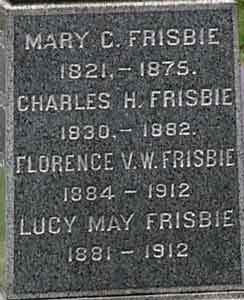
FRISBIE, CHARLES H. (1830-1882). Captain, United States Navy. Frisbie commanded some of the fastest ships sailing out of New York, including one that made the quickest passage between New York and China. Another one of his ships, the Jacob Bell, was captured by a Confederate privateer and burned after Captain Frisbie’s offer to fight a duel for possession of the ship was refused. He then joined the Navy, and commanded a gunboat in Admiral Farragut’s squadron during the Civil War. Upon his retirement from the Navy, Farragut presented him with the flag of the ship that he had commanded. His last address was 64 West 55th Street in New York City. Frisbie died of heart disease. Section 16, lot 10636.
FRITH, JOSEPH R. (1836-1906). Sergeant, 71st Regiment, New York State Militia, Company F. Frith, who was born in Manhattan, enlisted as a sergeant and mustered into 71st Regiment, New York State Militia, when it was activated for three months in 1861. His 1863 Draft Registration indicates that he was a bookkeeper. As per his obituaries in the Brooklyn Daily Eagle, the Brooklyn Standard Union and The New York Times, he worked as an inspector for more than 30 years with R. G. Dun & Company. R. G. Dun & Company was a pioneer in the business of credit reporting, an important tool in the growth of business in the 19th century. During his employment with the firm, he was manager of the Kansas City, Missouri, office in 1880 as recorded by the census and the Kansas City Directory for that year.
At the time of the Veterans Census of 1890, which confirms his Civil War service, he was working and living in Nashville, Tennessee. In 1900, the census notes that he was living in New York and working as a traveling auditor, but in 1901, he was headed to Omaha, Nebraska, to head R. G. Dun’s office there. (In 1933, Dun merged with its major competitor, J. M. Bradstreet, forming Dun & Bradstreet.) He was a member in the Grand Army of the Republic’s Winchester Post #197 in Brooklyn. His last residence was at 248 McDonough Street in Brooklyn. In 1909, Josephine Frith, who is interred with him, applied for and received a widow’s pension, certificate 696,281. Section 175, lot 18011, grave 3.
FRITSCHLER (or FRITCHLER), CHARLES L. R. (1839-1893). Private, 84th New York (14th Brooklyn) Infantry; 5th New York Veteran Infantry, Company H. Originally from Baltimore, Maryland, and a stone-cutter at the time of his enlistment, Fritschler was 5′ 8½”tall with blue eyes, light hair and a fair complexion. After enlisting and mustering into the 14th Brooklyn as a private on September 10, 1862, he transferred into the 5th New York Veterans on June 2, 1864. Fritschler was wounded at Weldon Railroad (also known as 6 Mile House), Virginia, on August 18, 1864, hospitalized at Lincoln General Hospital in Washington, D.C., and was discharged for disability on May 11, 1865, from Lexington Avenue General Hospital at New York City. On June 17, 1865, his application for an invalid pension was granted, certificate 44,851.
The Brooklyn Directory of 1889-1890 listed him as an undertaker. As per an article in the Brooklyn Daily Eagle on December 15, 1889, he was elected chaplain of Stephen Thatford Post #3 of the G.A.R. His last address was 422 8th Street in Brooklyn. The cause of his death was phthisis. Section 91, lot 24370.
FROELICK, LOUIS WEST (1834-1912). Sergeant, 71st Regiment, New York State National Guard, Company E. A native of Manhattan, Froelick was educated in the public schools. During the Civil War, he enlisted at New York City as a sergeant on June 28, 1862, mustered into the 71st Regiment that day, and mustered out with his company after three months at New York City on September 2.
According to his obituary in the Brooklyn Daily Eagle, which confirms his Civil War service, he formed the firm of Wiggers & Froelick in 1869 which manufactured jewelry display cases. The census of 1880 indicates that he was a manufacturer; the 1900 census reports that he was a jewelry case maker. The Veterans Schedule of 1890 confirms Froelick’s Civil War service. He retired from business in 1905. In 1908, his pension application was approved, certificate 1,150,673. He last lived at 721 East 21st Street in Brooklyn. Sarah Froelick, who is interred with him, applied for and received a widow’s pension shortly after his death in 1912, certificate 750,725.
On February 5, 1919, an article in the Jewelers’ Circular-Weekly detailed the history of the firm of Wiggers & Froelich over its fifty years of business. The article noted that the concern switched to the manufacture of jewelry trays and sample cases for salesmen but was currently engaged in Government contract work making cases for the Government Medical Supply Department that were needed during the World War. His death was due to toxemia (blood poisoning). Section 172, lot 14207, grave 2.
FROMME, EDWARD (1832-1906). Private, 41st New York Infantry, Company I. A native of Berlin, Germany, Fromme immigrated to the United States in 1855. During the Civil War, he enlisted and mustered into the 41st New York on June 6, 1861, at New York City, and was discharged on May 23, 1862, at Franklin, Tennessee. His application for an invalid pension was approved in 1879, certificate 739,671. The census of 1880 reports that he was employed as a cigar maker. In 1889, he became a trustee in the New York Order of United Friends, a fraternal benefit society.
On July 31, 1890, Fromme was the subject of reports in the Brooklyn Standard Union and the Brooklyn Daily Eagle about a strange shooting. Fromme, after a night of card-playing and drinking at a saloon on Fourth Avenue and 65th Street in Brooklyn, missed his train and began to walk to his home at 401 Warren Street. On the way, he encountered a stranger and after an altercation in which Fromme admittedly struck the man first, the man pulled a revolver and Fromme ran, but was struck by bullets to his left breast and behind his left ear. Despite being bloodied and injured, Fromme ran for his life and awoke on 92th Street near Fort Hamilton—and later insisted to skeptical police investigators that the shooter and his friends carried him there. He then made his way home where his wife found him in bed, bleeding from his wounds. The doctor removed the bullets, reported the story to the local precinct, and Fromme recounted the same story to the police. The Brooklyn Daily Eagle reported that Fromme was a large man with a disagreeable disposition who took pride in wearing a Grand Army button in his coat’s buttonhole. The Brooklyn Standard Union quoted Fromme as saying, “I fought in the army and am not afraid of two little bullet holes.”
The New York State census of 1892 notes that Fromme was a cigar maker; in 1893, he was a night inspector at the Customs House. He is listed as an inspector in the Brooklyn Directory for 1904. As per his obituary in the Brooklyn Daily Eagle, which confirmed his Civil War service, he was a member of the Federal Republican Club, the Clarence Mackenzie (see) Post #399 of the G.A.R., and the Brooklyn Turn Verein, a German cultural and gymnastics association. His last residence was 461 Warren Street in Brooklyn. Pneumonia caused his death. Elizabeth Fromme, who is interred with him, applied for and received a widow’s pension shortly after his death in 1906, certificate 719,420. Section 85, lot 32200, grave 2.
FROSSARD (or FROSORTH), EUGENE (or EDWARD) (1841-1894). Captain, 31st New York Infantry, Companies G, H, F, A and I; first lieutenant, 5th New York Veteran Infantry; private, 173rd New York Infantry, Company G. A Swiss native (as per his death certificate), he immigrated to the United States in 1858. His pension index record notes that he used an alias of Edward Frossard. He enlisted as a private on May 13, 1861, at New York City, using the name Edward Frossard, and mustered into Company G of the 31st New York on May 27. (His soldier paperwork notes that he was also borne on the rolls as Edward Frosorth.) According to his soldier record, he was promoted to sergeant major on June 14, 1861, and then received a promotion to second lieutenant on August 11, 1861, effective upon his transfer that day to Company H. He was listed as wounded on May 7, 1862, at West Point, Virginia, and transferred that day to Company F simultaneous with a promotion to first lieutenant. Frossard was wounded on June 27, 1862, at Gaines’ Mills, Virginia. He was promoted to captain on July 6, 1862, effective upon his transfer to Company A on November 14, 1862. He was transferred to Company H on April 1, 1863, then to Company I on April 15, and mustered out with his company at New York City on June 4, 1863. His rank and companies served are not validated by his muster roll; his muster roll notes that he was commissioned second lieutenant on July 4, 1861 (as of Company A), with rank from his enlistment date, additional service in Company B, and again commissioned as second lieutenant on December 20, 1862 (when he was transferred to Company E). His pension index also reports that he served in Companies A, B, and E of the 31st New York.
Frossard re-enlisted as a first lieutenant at New York City on August 31, 1863, and was immediately commissioned into the 5th New York Veteran Infantry. As per Sexual Behavior in the Civil War: A Compendium by Thomas P. Lowry, “In December 1863, Lieutenant Eugene Frossard of the 5th New York Veteran Volunteers, was charged with being drunk in an Alexandria house of prostitution and of refusing to pay for the wine he had consumed. He was acquitted of this charge, but was cashiered, after only a few months with his regiment, for threatening two civilians with his pistol.” He was dismissed from service on January 23, 1864. Subsequently, he re-enlisted as a private at New York City on February 22, 1864, mustered immediately into Company G of the 173rd New York, and mustered out on October 18, 1865, at Savannah, Georgia.
The 1880 census lists his birthplace as France and indicates that he was employed as a watch-maker. He last lived at 364½ Eighth Avenue in Brooklyn. He succumbed to cirrhosis. Shortly after his death in 1894, Julia Frossard, who is interred with him, applied for and received a widow’s pension, certificate 405,217. In 1902, after Julia Frossard’s death, a minor was awarded a pension, certificate 561,475. Section 135, lot 27263, grave 1836.
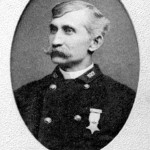
FROST, ALBERT H. (1843-1917). Corporal, 139th New York Infantry, Company C. A native of Brooklyn, he was employed in men’s haberdashery before he entered the service. He enlisted as a private on September 2, 1862, mustered into the 139th New York, and rose to the rank of corporal. He participated in these Virginia battles among others: Second Battle of Williamsburg, Drewry’s Bluff, and Cold Harbor. After the latter engagement, he was suffering from a fever and was sent for several months to the Balfour United States General Hospital in Portsmouth, Virginia, for convalescence. He remained at the hospital as a clerk in the private office of a surgeon and mustered out on June 5, 1865.
Returning to civilian life, Frost left his former position to join the Register’s Department of the Post Office. He was a charter member of the G.A.R.’s Ulysses S. Grant Post #327 and served in the Guard of Honor at President Grant’s funeral. He is listed as having served in the Civil War in the 1890 Brooklyn Veterans Census. His application for an invalid pension was granted in 1905, certificate 1,111,621. He last resided at 473 Halsey Street in Brooklyn. His death was attributed to bronchitis. In 1917, Mary Clara Frost, who is interred with him, applied for and received a widow’s pension, certificate 869,007. Section 41, lot 3083.
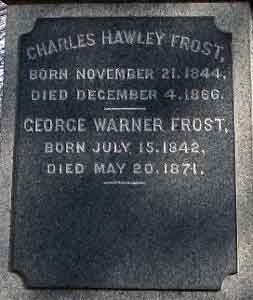
FROST, CHARLES HAWLEY (1844-1866). Private, 159th New York Infantry, Company I. A New York State native, Frost enlisted at Brooklyn and mustered into the 159th New York on November 20, 1863, and mustered out of service at Augusta, Georgia, on October 12, 1865. His last residence was on DeKalb Avenue in Brooklyn where he died from consumption. Section 21, lot 8872.
FROST, WILLIAM H. (or A.) (1844-1883). Private, 131st New York Infantry, Company A. On July 22, 1862, Frost, a native of New York City, enlisted there as a private. On September 9, 1862, he mustered into the 131st New York where he served until he mustered out on July 26, 1865, at Savannah, Georgia. After the War, Frost was a member of the G.A.R.’s William Rankin Post #10. He last resided at 240 Bergen Street, Brooklyn. Pneumonia was the cause of his death. Section 2, lot 5499, grave 1956.
FROTHINGHAM, JOHN BOUND (1840-1914). Private, 5th Massachusetts Volunteers, Company K. Originally from Charlestown, Massachusetts, where he was employed as a clerk, Frothingham enlisted there as a private on May 15, 1861, and mustered that day into the 5th Massachusetts Volunteers. He was at the Battle of First Bull Run, Virginia. He mustered out at Boston, Massachusetts, after three months on July 31, 1861. After he relocated to Brooklyn, where he worked as a clerk and bookkeeper, he became active in the New York State National Guard beginning with his enlistment as a private in the 23rd Regiment on December 3, 1869. His obituary in The New York Times reports that Frothingham was considered the best marksman in the New York National Guard. He rose to corporal on March 4, 1870, and then to sergeant on January 3, 1872. On April 6, 1874, he was appointed adjutant of the regiment, was the unanimous choice for major on January 10, 1880, and was promoted to lieutenant colonel on April 11, 1881. As per an article in The New York Times on May 20, 1894, he was selected by Colonel James McLeer (see) of the 14th Regiment to be his chief aide and representative of the adjutant general for the Second Brigade of the New York National Guard. Frothingham retired from the latter position in 1900. He was brevetted brigadier general by New York’s Governor Theodore Roosevelt.
The censuses of 1900 and 1910 indicate that Frothingham was the secretary of the National Lead Company. At the time of his passport application in 1909, he was 5′ 10″ tall with gray eyes and hair, a full face, “natural nose and mouth” and fair complexion. As per his obituary in the Brooklyn Daily Eagle, members of the 23rd National Guard and its Veteran Organization were invited to attend his funeral. Frothingham last lived at 233 Stuyvesant Avenue in Brooklyn. The cause of his death was nephritis. Section 181, lot 10968.

FROTHINGHAM, JOHN BRADBURY (1828-1881). Colonel by brevet; lieutenant colonel and aide-de-camp, United States Volunteers, major, 6th West Virginia Infantry. Born in Massachusetts, Frothingham was a civil engineer living in Toledo, Ohio, as per the census of 1860. In 1860, Toledo was a growing city that was a railroad center. During the Civil War, he enlisted as a major on November 1, 1861, and was commissioned that day into the Field and Staff of the 6th West Virginia. On July 9, 1862, Brigadier General B. F. Kelly wrote to President Abraham Lincoln requesting that Frothingham be promoted to lieutenant colonel and aide-de-camp. In that letter, Kelly noted that Frothingham served as a topographical engineer and took over command when Kelly was disabled. He wrote, “…Major Frothingham is a highly accomplished, scientific and gallant officer, and has rendered distinguished and important services in his sphere of duty….” Frothingham received that promotion on July 16, 1862, and was immediately commissioned into United States Volunteers. On July 30, 1862, he wrote a letter accepting his commission and noted that he then was living in Toledo, Ohio. He resigned on March 2, 1865. Later that month, on March 13, he was promoted to colonel by brevet.
The 1870 census notes that Frothingham worked at the Custom House in New York City; the 1873 Brooklyn Directory and the 1880 census indicate that he was a lawyer. His obituary in the New York Herald, which confirms his Civil War service, reports that he was an engineer by trade who was engaged in the construction of the Southern Pacific Railroad, and last worked as an agent in the Custom House. That obituary also notes that President Rutherford B. Hayes nominated him for appraiser for the Port of New York but the Senate rejected the nomination.
At the time of his death, he was planning to travel West to look over some property and his wife and family had gone to Augusta, Maine, to stay with friends. Another article about his death in The New York Times of April 13, 1881, shed additional light on his demise and family situation. Frothingham died in the 1st Precinct Station House after being locked up for intoxication. He was found in a dazed condition on Washington Street. At the time of his arrest, he had 60 cents in his pocket, some keys, and a half a bottle of alcohol. Apparently, his wife had left him because of his drinking. His obituaries all noted his dapper dress, multi-talents and previous high- standing in the community. He last lived at the Clinton House in New York City. In 1891, Augusta Frothingham applied for and received a widow’s pension, certificate 392,810. Section 2, lot 5499, grave 588.
FRY, HORACE H. (1840-1916). Private, 26th Pennsylvania Infantry, Company H. A native of Philadelphia, Pennsylvania, Fry enlisted on June 19, 1863, and mustered into the 26th Pennsylvania (an emergency unit, organized to meet the threat from the impending invasion by Robert E. Lee’s Army of Northern Virginia) that same day, and mustered out on July 30, 1863. At some point during his service, he was wounded in the head, taken prisoner and then paroled.
The 1880 United States census reports that he was living in Philadelphia and working as an iron molder. As per his obituary in the Brooklyn Standard Union, he was associated with the firm of Royer Brothers, specialists in cast iron architecture, for twenty-five years. The censuses of 1900 and 1910 state that he was a foreman for a yarn manufacturer in Manhattan. He is listed as having Civil War service in the Brooklyn 1890 Veterans Census. His obituary, which notes his Civil War service, reports that he had been a member of the Philadelphia Volunteer Fire Department. He last lived with his daughter on Palatina Avenue in Hollis, Queens. His death was attributed to stomach cancer. Section 205, lot 30504, grave 3.
FRYE, SAMUEL A. (or H.) (1833-1883). Sergeant, 12th Regiment, New York State Militia, Company B; 65th New York Infantry, Company G. A native of New York, Frye enlisted as a private in 1861 for a period of three months and mustered into Company B of the 12th Regiment. On August 24, 1861, he re-enlisted at New York City as a private and mustered into Company G of the 65th New York that same day. He served throughout the Civil War, was promoted to sergeant at some point but then reduced to the rank of private on an unknown date. On April 15, 1865, he was arrested and deserted on June 16, 1865. His pension record indicates that he also saw unassigned service in the 71st New York National Guard.
As per the census of 1870, he was a carpenter; the New York City Directory of 1874 indicates that he was a builder. Frye last resided at 25 Bayard Street in Manhattan. He died from phthisis. His widow, Henrietta M. Frye, who is interred with him, applied for a pension in 1890, application 531,104, but there is no indication that it was certified. Section 106, lot 11917.
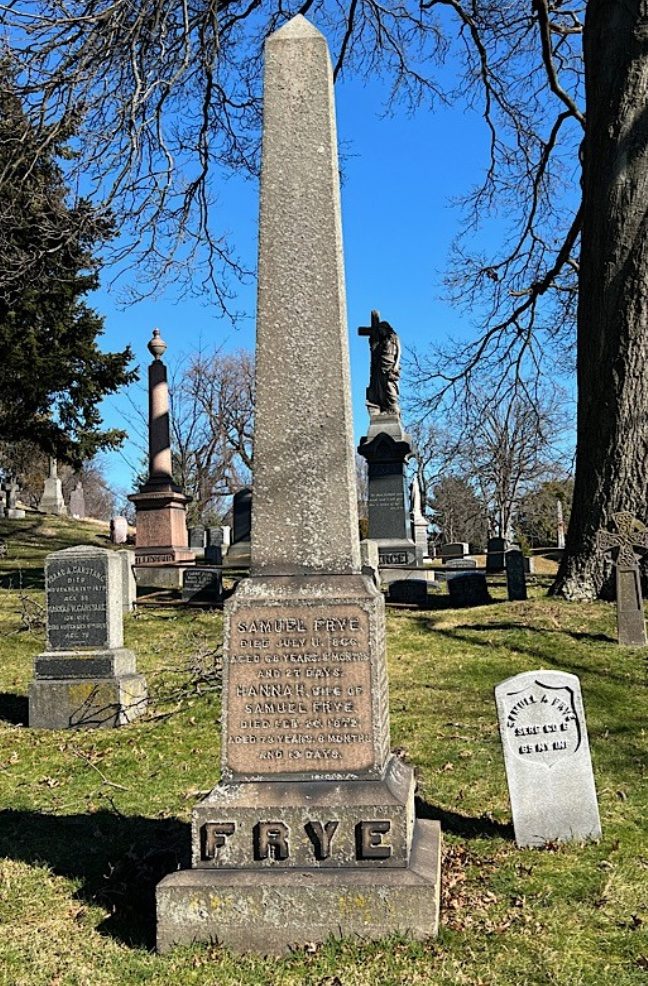
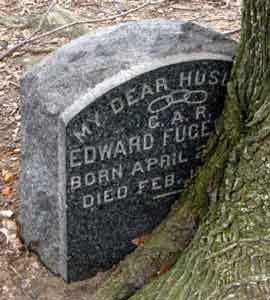
FUGELSANG, EDWARD (also enlisted as HOFFMAN, JOHN) (1847-1899). Private, 23rd Connecticut Infantry, Company I; 11th Connecticut Infantry, Company G. Originally from Germany, Fugelsang was a resident of Fairfield, Connecticut, when he enlisted on September 10, 1862. On November 14, he was drafted into Company I of the 23rd Connecticut from which he mustered out on August 31, 1863. He re-enlisted using the alias John Hoffman and served in the 11th Connecticut. Details of that service are unknown.
After the War, he was a member of the Grand Army of the Republic. According to the 1880 census, his occupation was engineer in a sugar refinery. His last residence was 146 Norman Avenue in Brooklyn. Shortly after his death attributed to “acute mania,” his widow received a pension, certificate 582,332. Section 135, lot 30010, grave 87.

FULCHER, JOHN H. (1841-1903). Acting third assistant engineer, United States Navy. Originally from England, his family immigrated to the United States when he was four years old. On August 28, 1863, he enlisted as a volunteer engineer in the United States Navy and was assigned to the USS Dai Ching, a vessel in the South Atlantic Blockading Squadron that participated in assaults off the coast of South Carolina. On January 26, 1865, after capturing the Coquette, a schooner loaded with cotton, the Dai Ching was grounded by Confederate gunfire and was set afire by her officers and crew, all of whom safely escaped. Fulcher was slightly wounded in the assault that day as per the assistant surgeon’s report.
After the Civil War, he resided in Bridgeport, Connecticut, then relocated to Brooklyn where he was employed in the register’s office before studying law. A real estate and conveyance lawyer, he was admitted to the bar in 1880 and became renowned in his field. Remaining active in military affairs, he was a member of William Rankin Post #10 of the G.A.R. An avid bicyclist, he was a prominent member of the Long Island Wheelmen. He last lived at 44 Lincoln Place in Brooklyn. A cerebral hemorrhage caused his death. Section 196, lot 30308, grave 3.
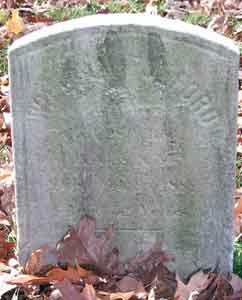
FULFORD, WILLIAM (1836-1888). Private, 28th Regiment, New York State National Guard, Company A. Fulford, a painter by trade, served for 100 days when the 28th Regiment was activated in 1864. The regiment, which was sent to Elmira, New York, mustered in on various dates in August and mustered out at New York City on November 13.
The censuses of 1870 and 1880 indicate that Fulford was a painter. As per his obituary in the Brooklyn Daily Eagle, he was a member of the Independent Order of Odd Fellows, a fraternal organization known for its altruistic activities. His last residence was 138 Cumberland Street, Brooklyn. In 1890, Margaret Fulford, who is interred with him, applied for and received a widow’s pension, certificate 295,786. Section 59, lot 1428, grave 29.
FULKERSON (0r FULKENSON), WILLIAM H. (1840-1912). Private, 8th Regiment, New York State National Guard, Company C. Fulkerson, a New York City native whose soldier record spells his name as Fulkenson, enlisted as a private at New York City on May 29, 1862, mustered into Company C of the 8th Regiment on that day, and mustered out at New York City with his company on September 10, 1862. The New York State census of 1865 reports that he was married, lived in Brooklyn and was employed as a grain dealer. As per the census of 1880, he lived in Brooklyn with his wife and three children and worked in a flour mill. In 1891, his application for an invalid pension was approved, certificate 761,881. The 1900 census notes that he had been married for thirty-six years. He last lived at 59 Grove Street in Brooklyn. His death was attributed to nephritis. Martha Fulkerson applied for and received a widow’s pension shortly after his death in 1912, certificate 745,564. Section 70, lot 7290, grave 7.
FULLER, CHARLES WESLEY (1825-1868). Quartermaster sergeant, 4th New York Cavalry, Company F; 9th New York Cavalry, Company E. Fuller, who was originally from Danville, Vermont, enlisted as a quartermaster sergeant at New York City on October 4, 1861, and mustered into the 4th New York Cavalry on that date. As per his muster roll, he was a compositor by trade who was six feet tall with hazel eyes, gray hair and a dark complexion. He was taken prisoner of war on June 9, 1862, at Harrisonburg, Virginia, and was paroled on September 13, 1862. On February 11, 1864, he re-enlisted at New York City, transferred into the 9th New York Cavalry on February 27, 1865, and mustered out at Cloud’s Mills, Virginia, on July 17, 1865. His last residence was 55 Fleet Street in Brooklyn where he died from consumption. Section 97, lot 16610.
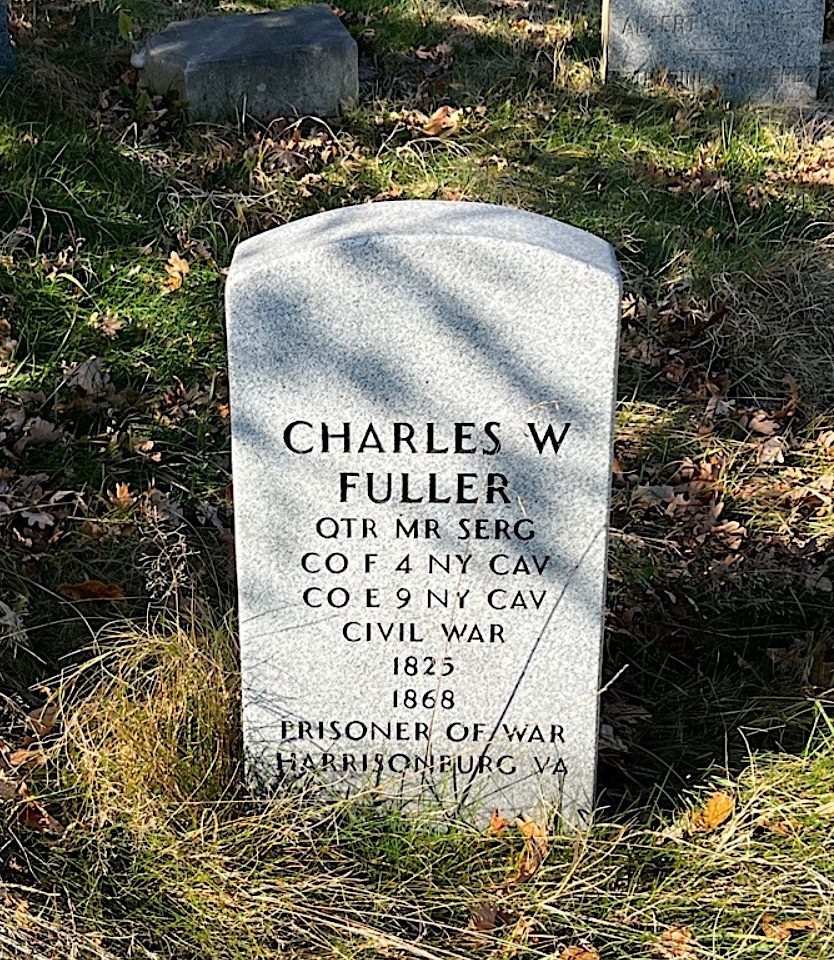
FULLER, JOHN JAMES (1835-1861). Master’s mate, United States Navy. Born in England, Fuller served as master’s mate aboard the USS Resolute. As reported by William Budd, commander of the steamer, Fuller was killed serving aboard this vessel on August 15, 1861, in an engagement off Matthias Point, Virginia. Budd wrote in his official report:
Sir: In obedience of you orders I proceeded down the river to make an examination of Matthias Point and the intermediate vicinity. Nothing indicating a hostile movement could be discovered at or about the Point. Hearing that a schooner was ashore at Lower Cedar Point I thought it advisable to go down to her and get her off if possible. A boat was seen on the Virginia shore a short distance this side of Persimmon Point, and I dispatched an officer and five men in a boat for the purpose of capturing her. They had just reached her, and were in the act of making fast when a volley of musketry was fired from the adjoining bushes, not more than five or six yards distant, instantly killing three of the boat’s crew and wounding another. I immediately opened fire, throwing shell into the cover that sheltered the enemy. After four or five rounds, they were driven out, running in parties of three and four in different directions, some of them going into some dwelling houses on the right. The survivors of the boat’s crew succeeded in getting her off from the shore while I was firing. The Reliance coming up at this moment commenced throwing shell at the flying enemy, and also sent a boat to assist in getting my boat off. Nothing was left behind. My boat is completely riddled, particularly in the aft part. The attacking party numbered about thirty. Lieutenant Mygatt remained with his vessel in the vicinity until I could report to you. The following persons were killed and wounded: -Killed, John Fuller, master’s mate; Geo. Seymour, seaman; Tlios Tully, seaman. Wounded, Ernest Walton, seaman. The men who escaped state that the boat on the shore had two casks in her. We were unable to secure her. Very respectfully, Wm. Budd
Section B, lot 8575, grave 1197.
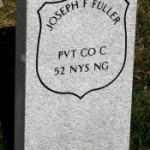
FULLER, JOSEPH F. (1846-1863). Private, 52nd Regiment, New York State National Guard, Company C. He enlisted and mustered into the 52nd Regiment on June 18, 1863. His regiment left for Harrisburg, Pennsylvania, on June 22 and was attached to the Department of the Susquehanna. Although the unit was activated for 30 days, he died in Brooklyn on July 24, one day before his company mustered out on July 25. Section 115, lot 13536 (Soldiers’ Lot), grave 88.
FULLER, LEVI AUGUSTUS (1834-1904). Captain, 31st New York Infantry, Company D. Fuller was born in Northbridge, Massachusetts. During the Civil War, he enlisted as a captain at Alexandria, Virginia, on August 7, 1861, and was commissioned into Company D on that same date. He resigned on January 14, 1863.
Fuller mustered into the John Adams Dix Post #135 of the G.A.R. on October 7, 1884; at that time, he lived in New York City and was a lawyer. In 1891, his application for an invalid pension was approved, certificate 1,074,545. As per the census of 1900, he lived at 110 St. James Place in Brooklyn, was retired and had been married for 20 years. He last lived on St. James Place in Brooklyn. His death was attributed to heart disease. Section 185, lot 18445, graves 7 and 8.
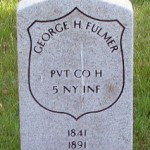
FULMER, GEORGE H. (1841-1891). Private, 5th New York Infantry, Company H. Fulmer enlisted at New York City, his birthplace, on July 9, 1861, and mustered into the 5th on that date. A clerk by trade, he was 5′ 10¼” with blue eyes and brown hair. On September 6, 1862, he was discharged for disability at Henry House, Virginia, after falling sick from exposure at Harrison’s Landing, Virginia, in July 1862. In 1890, his application for an invalid pension was approved, certificate 489,657. The Veterans Census of 1890 confirms his Civil War service and indicates that he was wounded in the left shoulder during the War. At that time, he was living in Rockaway, New Jersey. As per his obituary in the New York Herald, he was a Freemason. His death was attributed to paralysis. Shortly after his death in 1891, Mary Fulmer, who is interred with him, applied for and received a widow’s pension, certificate 334,047. Section 187, lot 20070.
FULTON, JOHN W. (1845-1893). Private, 2nd New York Cavalry, Company L. Fulton was originally from Antrim County, Ireland. After enlisting as a private at Albany, New York, on September 3, 1864, he mustered into the 2nd New York Cavalry that day. As per his muster roll, he was a sailor who was 5′ 5¼” tall with gray eyes, brown hair and a light complexion. He mustered out on June 5, 1865.
After the Civil War, Fulton was a member of the G.A.R.’s James McQuade Post #557. In 1890, his application for an invalid pension was approved under certificate 635,932. According to the New York City Directory for 1891, he worked as a clerk; the 1892 Directory lists him as a contractor. A Freemason, he last lived at 467 Columbus Avenue in Manhattan. He died from heart disease. In 1894, Mary Jane Fulton, who is interred with him, applied for and received a widow’s pension, certificate 394,787. Section 17, lot 17245, grave 925.

FUNK, AUGUSTUS (1841-1883). Captain, major, and lieutenant colonel by brevet; colonel, 39th New York Infantry; major, 38th New York Infantry, Companies C and H. Originally interred at Green-Wood, his remains were removed on November 1, 1892. Although cemetery records list Funk as German by birth, his soldier record states that he was born in Florida. After enlisting at East New York as a second lieutenant on May 7, 1861, he was commissioned into Company C of the 38th New York on June 3, and became a first lieutenant on August 6. He rose to captain on January 11, 1862, effective upon his transfer to Company H on February 12 and was wounded on May 5, 1862, at Williamsburg, Virginia. Funk was promoted to major on October 10, 1862, transferred into the Field and Staff on November 17, and mustered out on June 22, 1863, at East New York. After re-enlisting on January 20, 1864, he was promoted to colonel and commissioned into the 39th New York, and mustered out on July 1, 1865, at Alexandria, Virginia. Brevetted to captain on March 2, 1867, for his actions at Wilderness, Virginia, he was also brevetted to major and lieutenant colonel that same day. Funk had subsequent service as a lieutenant in the 41st Infantry, United States Army, from July 28, 1866 through November 20, 1868. In 1874, he was elected colonel of the 11th Regiment and then became brigadier general of the Second Brigade, First Division in the State Militia.
As per his obituary in the New York Herald, he was involved in controversy in 1877 when troops were parading in Prospect Park. Colonel Villmar of the 11th Regiment refused to obey his superior’s orders and was supported by his men. Funk arrested the whole regiment which was escorted to the Ludlow Street Jail. Funk then assembled the 96th Regiment and ordered them to secure Villmar’s armory by force. Villmar proffered charges against Funk who was forced to resign. In 1880, he filed for an invalid pension that was granted, certificate 167,313. He last lived at 12 East 28th Street in Manhattan. His obituary notes that Funk was the proprietor of Irving Hall in lower Manhattan and was active in Tammany Hall politics during Boss Tweed’s tenure. He died of heart disease.
In 1884, Sophia Funk applied for and received a widow’s pension, certificate 214,568. This award was after a fight with Helen Funk, who had previously applied for a widow’s pension in 1883, application 309,994. The widows’ dispute made headlines in the New York Herald in March 1907 after Sophia Funk died, four months after Helen Funk’s death. According to the article, Death Notice War of Funk Widows, Augustus Funk was first married to Sophia, who accompanied her husband into service as a Civil War nurse. She returned to New York after the War, entered society and became estranged from her husband in the 1870s. When Funk died intestate in 1883, Sophia went to court to claim her husband’s estate. She was challenged by Helen Funk who married Augustus in Salt Lake City, Utah, in 1878, where he obtained a divorce from Sophia. The surrogate ruled in favor of Sophia, claiming that neither Helen nor Augustus had been residents of Utah and therefore, their marriage was invalid. The 1907 article revived the bitter feelings of both families and sought to establish the identity of the “real” widow.
FUNK, JOHN H. (1817-1871). Private, 1st New York Light Artillery, Battery I. Funk was born in New York. According to the census of 1850, he was a carpenter whose real estate was valued at $21,600; the Brooklyn Directory for 1860 lists him as a builder. On March 5, 1861, when he testified in court about his sister’s will, he stated that he was a member of the Permanent Board of Water Commissioners in Brooklyn. Prior to that, he was president of the Lafayette Fire Insurance Company at 347 Fulton Street in Brooklyn. During the Civil War, he enlisted at Buffalo, New York, as a private, on November 9, 1861. On January 6, 1862, he mustered into Battery I of 1st New York Light Artillery and was discharged for disability at Washington, D.C., on November 16, 1862.
In 1863, Funk purchased the house that is now the site of the Brooklyn Historical Society at 128 Pierrepont Street in Brooklyn. As per the census of 1870, he was a builder whose real estate was valued at $400,000, and whose personal estate was worth $10,000. He was listed as a builder in the 1871 Brooklyn Directory. Many of his buildings are in the historic Clinton Hill section of Brooklyn. As per his obituary in the Brooklyn Daily Union, his fellow Freemasons and numerous prominent New Yorkers were in attendance at his funeral which was led by the Reverend Henry Ward Beecher (see). Funk was laid to rest in a rosewood casket adorned with iron moldings and trimmed in white satin with the lining of the lid arranged in the shape of the rising sun. Thirty carriages were part of the funeral procession to the family’s lot. His last residence was 36 Clinton Street, Brooklyn. His death was due to apoplexy. Section 79, lot 3055.
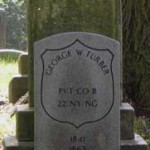
FURBER, GEORGE W. (1841-1863). Private, 22nd Regiment, New York State National Guard, Company B. A New Yorker by birth, Furber served for 30 days in the National Guard in 1863. He died from consumption later that year at his residence in Woodside, Queens. Section 25, lot 3029.

FURLONG, CHARLES EDWARD (1840-1907). First lieutenant, 17th Wisconsin Infantry, Company F. Likely born in Kilkenny, Ireland, he was a resident and store clerk in Madison, Wisconsin, when he raised enough men for the 17th Wisconsin (the Irish organization of state volunteers) to earn the commission as a first lieutenant on March 10, 1862. He was promoted to quartermaster on September 30, 1862, and transferred that day into the Field and Staff. During his service, he befriended General Ulysses S. Grant and remained a friend of the Grant family when he returned to civilian life in New York. He mustered out on March 10, 1865.
It was after the Civil War when Furlong’s life became colorful, notorious, and to some extent, subject to contradiction. A carpetbagger, he went to Vicksburg, Mississippi, opened a general store, and apparently made a fortune there. Furlong was sheriff in Warren County, Mississippi (a tenure marked by corruption from 1867 through 1873), was elected to the State Senate, and was active in the movement to impeach Mississippi’s Governor Ames. When James Alcorn, a Republican, became governor and raised a militia to address racial tensions, Furlong sided with him and was commissioned major general. He soon sold his business and left for New York. His obituary in The New York Times noted that not much was known about his private life but that he was close to the Grant family and was sent by President Grant to Mississippi after the War where he took an active part in reorganizing the state government. The obituary also notes that he did “reconstruction” work in Alabama and Louisiana. That information was countered by a Times interview with an informant a week later who stated that Furlong was in Vicksburg at the end of the War, befriended the blacks who put him in office, and had no formal working relationship with Grant.
In any event, Furlong came to New York in about 1875, lived in Manhattan’s Fifth Avenue Hotel, traveled extensively, and belonged to a local political club, The Amen Corner, hosted by New York’s Senator Thomas Platt, but apparently did not have any record of employment. Furlong formed the Anti-Sedentary Club at the Fifth Avenue Hotel, claimed to walk 25 miles a day and went on walking trips in all parts of the world including Japan, India and Afghanistan. An eccentric, Furlong left a fortune of $150,000 when he died; no relatives were at his funeral. In his will, he left money to numerous charities, to staff members at the Fifth Avenue Hotel, and to some relatives in Ireland. He died of diabetes gangrene on September 25, 1907, in Portland, Maine, and expressed a wish in his will that he be buried at Green-Wood Cemetery, allocating $10,000 for arrangements. He was buried there on August 11, 1908. Section 199, lot 32831.
FURMAN, GUIDO J. F. (1831-1896). Surgeon, 4th Regiment, New York State National Guard. Born in Nassau, Germany, he immigrated to the United States when he was sixteen. As per his obituary in The New York Times, Furman was a graduate of the City University of New York, a member of the Academy of Medicine and a life member of the Pathological Society. During the Civil War, he enlisted at New York City as a surgeon on June 20, 1863, mustered into the Field and Staff of the 4th Regiment’s National Guard on July 18, and mustered out on July 24, 1863, at New York City.
Furman is listed as a physician in the 1886 New York City Directory. The 1890 Veterans Schedule confirms his Civil War service. In addition to his medical practice, he was a Freemason. He last lived at 254 West 84th Street in Manhattan. His death was caused by heart disease. Section 178, lot 12248, grave 2.
FURMAN (or FERMAN, FIRMAN), WILLIAM H. (1828-1871). Private, 5th Independent Battery, New York Light Artillery. Furman was born in Brooklyn. A marker near Furman’s grave indicates that he served during the Mexican War. The 1855 New York State census reports that he was married with two young children, lived in Brooklyn and worked as a mechanic. During the Civil War, Furman enlisted as a private at Brooklyn on November 1, 1862, and mustered into the 5th Light Artillery on November 11. As per his 1863 Draft Registration of July 1863 , he was married and an engineer. The 1865 New York State census notes that he was an engineer currently in the Army and lived in a frame house valued at $1,500. He mustered out on Hart’s Island, New York Harbor, on July 6, 1865.
The 1867 Brooklyn Directory lists Furman as a farmer living on Fulton Avenue and Broadway. According to the 1870 census, he was married with three children, lived in Brooklyn and worked as an engineer. He was a member of the Dutch Reformed Church. He last lived on 19th Street in Brooklyn. His death was attributed to consumption. In 1875, Mary A. Furman, who is interred with him, applied for and received a widow’s pension, certificate 174,860. Section 143, lot 22340.
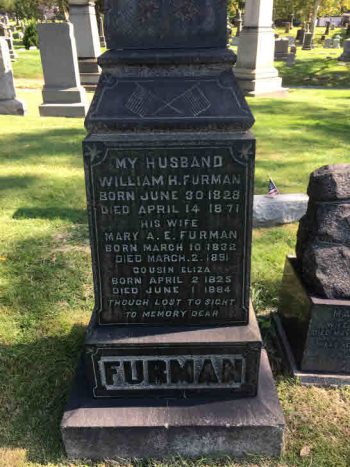
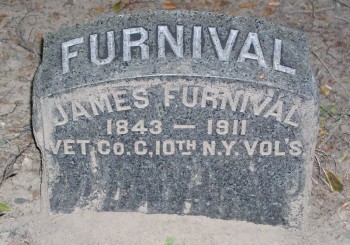
FURNIVAL, JAMES (1843-1911). Private, 10th New York Infantry, Company C. After enlisting at New York City on April 26, 1861, he mustered into the 10th four days later, and mustered out on May 7, 1863, at New York City. He was a mail carrier as per the Brooklyn Directory for 1888; the 1889 Brooklyn Directory lists him as a policeman. The 1890 Veterans Schedule confirms his Civil War service. Furnival received an invalid pension in 1892, certificate 1,118,839. The census for 1900 reports that Furnival was employed as a policeman. His last address was 506 11th Street in Brooklyn. He died of arteriosclerosis. Section 87, lot 1715, grave 92.

GABLER, RUDOLPH (or RUDOLF) (1831-1904). Private, 7th New York Infantry, Company G. Born in Silesia, Austria, although other official documents indicate Germany, Gabler immigrated to the United States in 1865. As per the Veterans Schedule of 1890, he enlisted on April 13, 1865, served in Company G of the 7th New York, and was discharged on August 4, 1865. Gabler became a naturalized citizen on December 26, 1865. His citizenship papers confirm his honorable discharge. In 1873, his application for an invalid pension was approved, certificate 573,615.
The 1879 New York City Directory lists Gabler as a case maker. On October 26, 1881, he was admitted to the Almshouse on Bedloe’s Island, New York City, suffering from drunkenness. He listed his employment as a showcase maker, stated that he could read and write, and was expected to be confined for six months. From November 5, 1887 until June 17, 1891, Gabler resided at the Milwaukee Home for Disabled Soldiers. His records there indicate that he was a glazier and disabled by a hernia. He was then transferred to the Soldiers’ Home in Hampton, Virginia. The Veterans Schedule of 1890 confirms his service in the 7th New York and indicates that he suffered from a hernia. By 1900, he was at the Home for Disabled Veterans in Montgomery, Ohio. Records from the National Cemetery in Dayton, Ohio, state that soon after his death, caused by a cerebral hemorrhage, his body was shipped back to New York City. His last residence was 310 East 66th Street in Manhattan. Section 136, lot 28307, grave 1026.

GADSDEN, CHARLES A. (or C.) (1832-1862). First lieutenant and adjutant, 9th New York Infantry; private, 7th Regiment, New York State Militia, Company K. Of English birth, Gadsden was listed as a clerk in the 1857 New York City Directory. During the Civil War, he mustered into the 7th Regiment as a private on April 26, 1861, and mustered out with his company on June 3, 1861, at New York City. On March 13, 1862, he re-enlisted as a first lieutenant at Washington, D.C., and mustered into the 9th New York, also known as Hawkin’s Zoaves, as first lieutenant and adjutant on March 22 at Washington, D.C. Gadsden was killed in battle on April 19, 1862, at Camden, North Carolina, while gallantly leading the 9th New York. An article in the New York Evening Post on May 7, 1862, reported that the steamship Haze had arrived from Newbern, North Carolina, bearing the bodies of eighteen officers and soldiers killed at Camden, including Gadsden.
Gadsden’s funeral was held at the 7th Regiment Armory. His obituary in the New York Evening Express invited the members of the 7th Regiment to attend his funeral joining with his comrades from the 9th New York Infantry. Members of the 7th were asked to wear their dress uniforms (in overcoats, if stormy) and white gloves in tribute to the deceased’s memory. In his obituary in the New York Daily Tribune, Gadsden’s fellow Masons from Howard Lodge #35 were asked to meet at the Armory and accompany the remains to Green-Wood Cemetery.
Another article in the New York Daily Tribune on May 10 described the funeral which was largely attended by National Guardsmen and fellow Masons. The coffin, which was adorned with flowers and which bore a plaque inscribed “ADJUTANT CHARLES A. GADSDEN, Killed at the Battle of Camden, April 19, 1862, Aged 30 years, 5 months, and 21 days,” was placed in the Board of Officers room. The cortege to the cemetery was in this order: full band of the 7th Regiment, Company K of the 7th Regiment-75 men, hearse with detachment of Zouaves from the 9th Regiment along with pallbearers who were officers from the 9th Regiment, officers from the First Division, and carriages containing friends and relatives of the deceased. He was interred on May 9, 1862, with full military honors. In 1869, Robert Gadsden, his father, received a survivor’s pension, certificate 140,571. Section 98, lot 68.
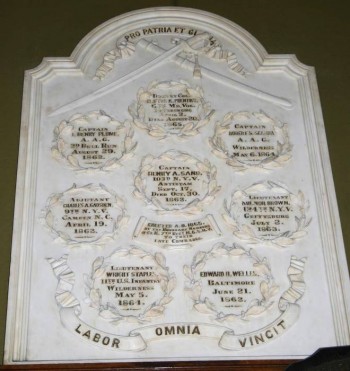
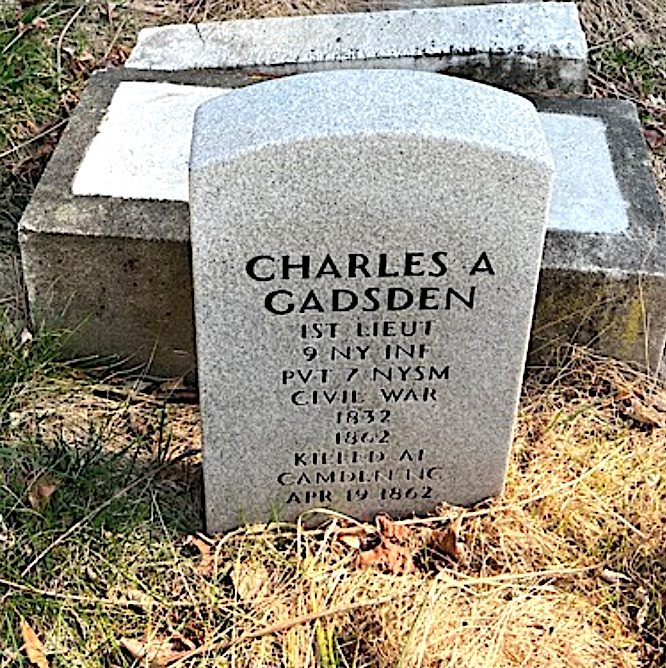
GAGE, GEORGE R. (1840-1901). Private, 23rd Connecticut Infantry, Company G. A New York City native, Gage enlisted as a private on November 12, 1862, mustered into the 23rd Connecticut Infantry on November 14, and mustered out on August 31, 1863. The Veterans Schedule of 1890 confirms his Civil War service. In 1890, Gage’s application for an invalid pension was approved, certificate 619,097. On July 12, 1897, when he mustered into the Abel Smith Post #435 of the G.A.R., he was living in Brooklyn and working as a United States gauger, a surveying officer who examines containers of wine, oil and other liquids to make sure that they meet all customs and excise laws. He last lived on Smith Lane and East 95th Street in Canarsie, Brooklyn. His death was attributed to cancer. Mary Gage, who is interred with him, applied for and received a widow’s pension in 1916, certificate 827,016. Section 20, lot 6828.
GAGE, ORANGE CHARLES (1842-1893). Private, 2nd Vermont Light Artillery. A native of Vergennes, Vermont, he was listed as a printer on the census of 1860. During the Civil War, Gage enlisted as a private at Rutland, Vermont, on December 8, 1863, and mustered immediately into the 2nd Vermont Light Artillery. As per his muster roll, he was procured by Rufus Mead, recruiting agent, who was entitled to a premium of $15. A printer by trade, Gage was 5′ 7″ tall with blue eyes, brown hair and a light complexion. He was discharged for disability on August 10, 1864. The census of 1870 indicates that he was working as a printer in Saratoga Springs, New York, but by 1875, he was a physician there. In 1876, his application for an invalid pension was approved under certificate 184,175. Gage is listed as a physician in the New York City Directory for 1880 with a home at 21 West 18th Street.
An article in the Saratogian (Saratoga Springs) on May 10, 1883, reports that Gage was arrested in Dover, New Hampshire, for practicing medicine without a license. However, a subsequent article in the Lowell Daily Inquirer on May 23, 1883, notes that Gage’s trial resulted in his “unconditional discharge, without costs.” According to the latter article, Gage, a graduate of the New York Eclectic College, practiced medicine for fourteen years outside the State of New Hampshire, and had applied for a license to practice there in January 1882. However, the New Hampshire Medical Society denied his application for violation of “medical etiquette” because Gage had advertised in local newspapers and traveled from place to place.
Another article in the Franklin Gazette (Malone, New York) in 1888 headlined “Extraordinary Medical Success” reports that Dr. O. C. Gage and Associate Physicians, who have had remarkable success curing difficult cases in Vermont and New Hampshire, would be available for consultations free of charge. Locals who were “cured” of ovarian tumors, deafness, crippled spines, and had received “Unequalled Cures” were named; but some of them had not even seen Dr. Gage. Gage also read a paper to the Saratoga District Society that was printed in Transactions of the Eclectic Medical Society enumerating his cures which included infusions of sarsaparilla, dwarf elder, wild cherry, black willow, etc. to cure disparate conditions such as eye disease, spinal meningitis, and prolapsed uterus. The 1892 New York City Directory indicates that he was a physician living at 26 West 31st Street in New York City. His death was caused by complications due to gangrene. Section 165, lot 28430, grave 5.
GAHAN, JOHN (1841-1877). Corporal, 155th New York Infantry, Company A. Enlisting as a corporal on August 12, 1862, at New York City, his birthplace, Gahan mustered into the 155th New York on November 18 of that year. He was wounded on June 3, 1864, at Cold Harbor, Virginia. At some point in his service, he was reduced in rank to private. On July 7, 1865, he mustered out at Washington, D.C. His application for an invalid pension was granted in 1875, certificate 123,645. He last resided at 181 Sackett Street in Brooklyn. His wife, Caroline, who is interred with him, applied for and received a widow’s pension in 1890, certificate 313,736. Section 177, lot 13705.
GAINSFORD, CHARLES (1827-1880). Acting master’s mate, United States Navy. Originally from Lubec, Maine, and a resident of New York, Gainsford enlisted in the United States Navy on April 11, 1862. He served on board the receiving ship USS Colorado as a mate. He also served on the steam-sloop USS Pensacola as an acting master’s mate. The 1877 Brooklyn Directory lists Gainsford as being in the Navy and living at the Brooklyn Navy Yard. As per his Brooklyn Naval Hospital ticket of December 1879, he contracted a heavy cold while on-board the USS Colorado which ultimately settled in his left lung leading to pneumonia and death. He died at the United States Naval Hospital in Brooklyn. Section 200, lot 23763.
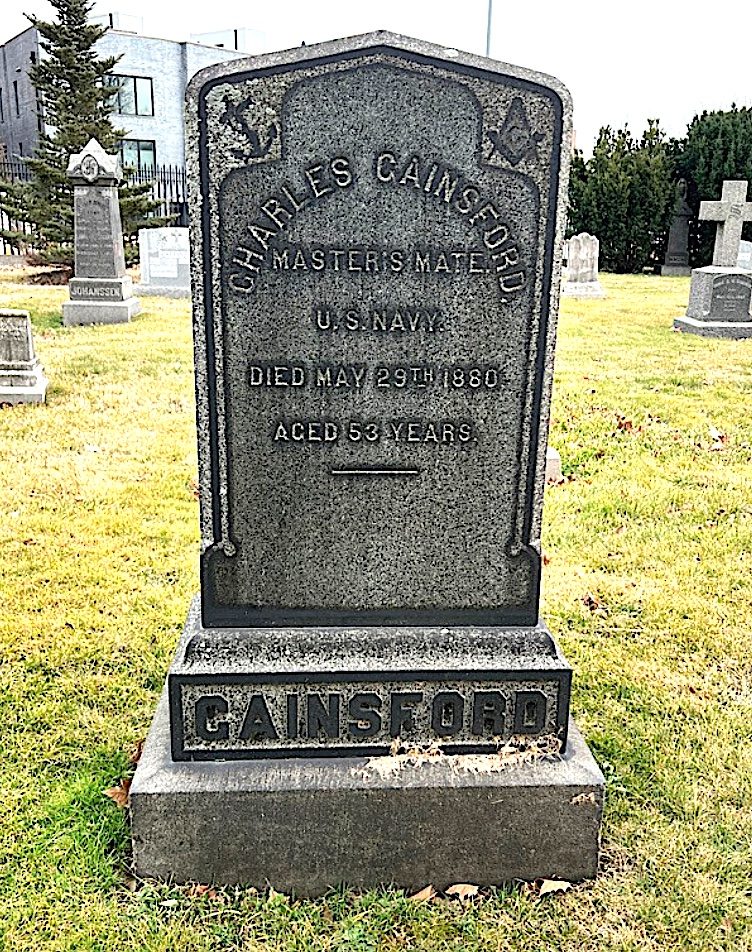

GALBRAITH, JOHN (1829-1894). Private, 170th New York Infantry, Company C. Born in Ireland, Galbraith enlisted as a private at New York City on September 15, 1862, and mustered into the 170th New York on October 7. He was wounded in action at Petersburg, Virginia, on June 24, 1864, and mustered out on July 15, 1865, at Washington, D.C. His last residence was 131 11th Street, Brooklyn. The cause of his death was heart disease. Section 62, lot 24374.
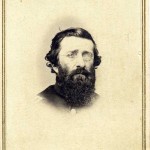
GALE, GEORGE SPAULDING (1814-1877). Surgeon, 1st Vermont Cavalry. Gale was born in Cornwall, Vermont, the son of General Sumers Gale, who earned distinction during the War of 1812, most notably at Plattsburgh, New York. George Gale graduated from Castleton Medical College in 1837, taught anatomy at Albany Medical College, and, after his marriage, relocated to Franklin County, Vermont, where he practiced medicine and surgery for five years. He later moved to Bridport, Vermont. Gale was heavy set, of average height with blue eyes, light hair and a light complexion.
As per his obituary in the Brooklyn Daily Eagle, the 1st Vermont Cavalry was raised in the fall of 1861. The regiment was composed of the finest Vermont families and the choice of surgeon for the regiment was determined by a competitive exam. Gale was chosen from many qualified applicants. An article in the St. Albans (Vermont) Messenger on November 14, 1861, praised Governor Holbrook’s appointment of Dr. George Gale as surgeon of the Vermont Cavalry. That article noted that Gale’s many friends in the community were gratified to hear about his success. The obituary goes on to note that, during the Civil War, Gale served with General Nathaniel Banks and General Philip Sheridan in the Shenandoah Valley in Hugh Judson Kilpatrick’s Division and George A. Custer’s Brigade and at one time was surgeon of the division.
Gale took a medical leave because of malaria for a few weeks in October 1862 and missed a few weeks in the summer of 1863 when he suffered from rheumatism. When his regiment was detailed to James River, Virginia, he was detailed to Cavalry Corps Hospital in City Point, Virginia, where he was for a large part of the time, surgeon-in-chief until the close of the hostilities. Although his obituary and biography note that he served throughout the Civil War, his soldier record indicates that he enlisted as a surgeon on September 24, 1864, was commissioned into the Field and Staff of the 1st Vermont Cavalry that day, and mustered out on November 18, 1864. On February 9, 1866, he was appointed surgeon of the New York City Pension Board. He last lived with his daughter at 107 Macon Street in Brooklyn. In the early 1870s, he moved to Brooklyn to practice medicine but was struck with paralysis about three years before his death; he never fully recovered. His death was attributed to necrencephalus (softening of the brain). Section 115, lot 21150.
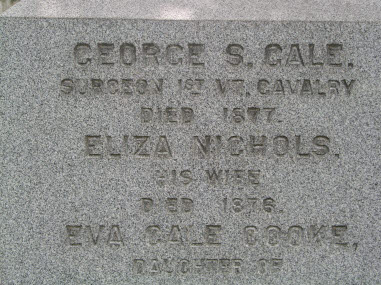
GALLAGHER, JOHN (1842-1927). Private, 90th New York Infantry, Company K. A native of Brooklyn, Gallagher enlisted there as a private on October 25, 1861, and mustered into the 90th New York the next day. He was wounded on June 14, 1863, at Port Hudson, Louisiana, necessitating the amputation of part of his finger. He mustered out on October 17, 1864, at New York City.
As per the 1870 census, he was a dock hand; the 1880 census indicates that he worked as a builder. In 1891, his application for an invalid pension was granted, certificate 816,596. At the time he entered the Soldiers’ Home on October 8, 1898, he was a dock builder who was 5′ 8″ tall with blue eyes, gray hair, a light complexion and was unable to read and write. As per the censuses of 1910 and 1920, he was living at the Soldiers’ Home in Bath, New York; he died there a victim of intestinal cancer. Section 127, lot 16311, grave 300.
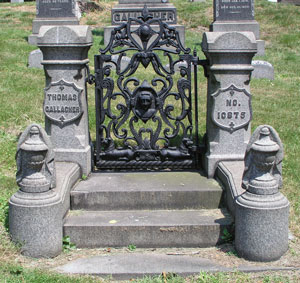
GALLAGHER, THOMAS (1825-1889). Sergeant, 79th New York Infantry, Company I. A native New Yorker, Gallagher enlisted as a private on May 13, 1861, at New York City, and mustered into the 79th New York on May 28. During his service, he was promoted to sergeant before he mustered out on May 31, 1864, at New York City. As per the census of 1870, he was a blacksmith; the census of 1880 indicates that he was a chair-manufacturer. The New York City Directory for 1884 lists him as an iron-worker—which may explain why a spectacular iron gate hangs in his Green-Wood lot.
An unidentified newspaper obituary states that Gallagher was a deeply religious man who the treasurer, steward and trustee of the Sunday school at the Madison Street Methodist Episcopal Church. In addition, he owned valuable property in Ocean Grove, New Jersey, the site of Methodist camp meetings dating from 1869, and was involved with the Sing-Sing Camp-Meeting Association, an annual outdoor summer gathering of Methodists in New York that began in the 1830s. He last lived at 279 Madison Street in Manhattan. He died of heart disease. Section 94, lot 10875.
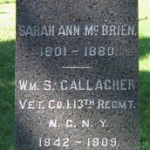
GALLAGHER, WILLIAM (1842-1909). Private, 127th New York Infantry, Company C. After enlisting on August 21, 1862, he mustered in two weeks later on September 8. While his regiment was on a march through Maryland, he deserted on July 16, 1863. His gravestone states that he served in the 13th National Guard of New York; it is unclear if that service occurred before, during or after the Civil War. His last residence was on Jamaica Avenue in Brooklyn. The cause of his death was rheumatism. Section 156, lot 16083.
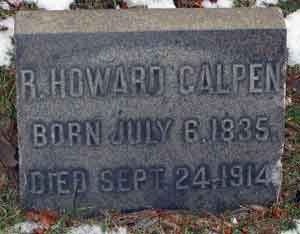
GALPEN, RICHARD HOWARD (1835-1914). First lieutenant, 37th Regiment, New York State National Guard, Company G. Born in Georgia, he was the son of Horace Galpin, a well-known Presbyterian minister there. (His father spelled the surname with an “i.”) Living on Staten Island and working as a clerk, he used the name Howard Galpen when he enlisted as a sergeant at New York City on May 29, 1862. He immediately mustered into the 37th Regiment for three months, and mustered out at New York City on September 2. When the 37th was reactivated in 1864, he re-enlisted with a promotion to first lieutenant on May 6, was commissioned into the same regiment and company, and mustered out after 30 days on June 6 at New York City. In 1864, the 37th was stationed at New York Harbor at Forts Richmond and Tompkins. Galpen remained in the regiment after the War and was promoted to captain of his company on April 7, 1866, effective as of March 21, and resigned his position three years later.
Active in military affairs, he was a member of the Veterans Associations of the 37th and 71st Regiments. (The 37th was consolidated into the 71st in 1870.) In civilian life, he was in a business that provided school supplies and furnishings. He successfully applied for a pension in 1902, certificate 1,140,740. His last address was 111 Holly Street in Cranford, New Jersey. He died of nephritis. Section 93, lot 3397, grave 1.
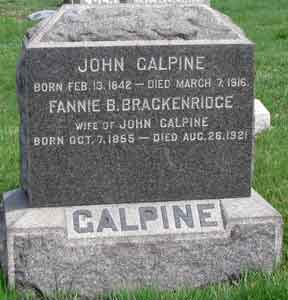
GALPINE, JOHN (1842-1916). Private, 28th Regiment, New York State National Guard, Company I. A Brooklynite by birth, Galpine was a pump worker as per the census of 1860. During the Civil War, he served for 100 days when the 28th Regiment was activated in 1864. The census of 1870 indicates that he was a journeyman painter and the Brooklyn Directory for 1876 lists him as a painter.
Galpine was elected as a prelate in his chapter of the Order of United Friends (O.U.F.), a fraternal organization. According to his obituary in the Brooklyn Standard Union, he was a lifelong resident of Brooklyn and a retired painter. His last residence was 641 Maple Street in Brooklyn. Galpine died from nephritis. Section 5, lot 34436, grave 2.
GAMBLE, THOMAS A. (1839-1885). Sergeant, 5th Independent Battery, New York Light Artillery. Originally from Pennsylvania, Gamble enlisted at Staten Island as a private on September 24, 1861, the same date that he mustered into the 5th Independent Battery, New York Light Artillery. As per his muster roll, he was a marble-cutter by trade who was 5′ 6½” tall with hazel eyes, brown hair and a light complexion. He re-enlisted on March 24, 1864. On August 16, 1864, he was promoted to corporal and became a sergeant on January 1, 1865. He was discharged from military service on July 6, 1865, at Hart’s Island, New York Harbor.
According to the 1870 census, Gamble was a stone-cutter; the 1880 census reports that he was a marble-cutter. He was likely a relative of William Gamble (see). His last residence was 405 West 18th Street in Manhattan. He died of apoplexy. In 1890, Rachael Gamble applied for and was granted a widow’s pension, certificate 348,024. Section A, lot 8100, grave 60.
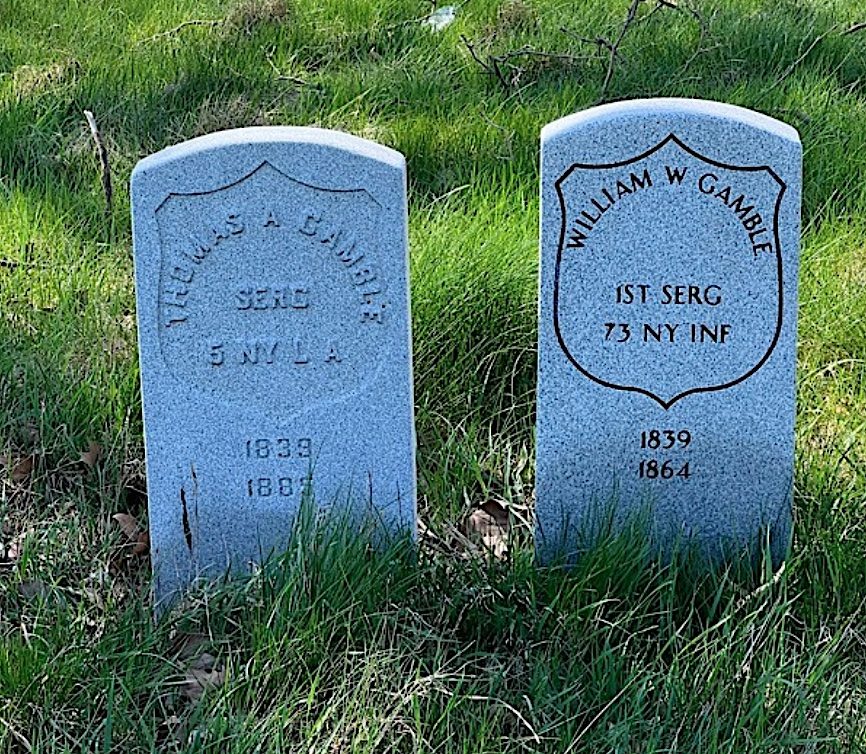
GAMBLE, WILLIAM W. (1841-1864). First sergeant, 73rd New York Infantry, Companies E and F. Born in New York and a resident of 163 West 33rd Street in Manhattan, he enlisted as a private on August 12, 1861, at Camp Decker, New York, and mustered into Company E of the 133rd New York two days later. Upon his promotion to corporal on September 1, he was transferred into Company F that day. He rose to sergeant on July 1, 1862, and to first sergeant on July 1, 1864. Gamble was killed in action on September 16, 1864, at the Battle of Petersburg, Virginia. Most likely, he was a relative of Thomas Gamble (see). Section B, lot 8100, grave 60.

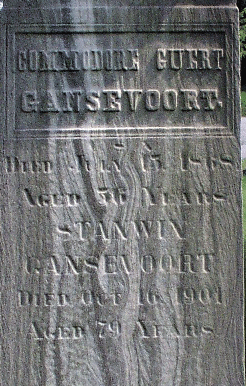
GANSEVOORT, GUERT (1812-1868). Captain, United States Navy. Born in Gansevoort, New York (near Albany), he began his career in the Navy as a midshipman on March 4, 1823. He became a lieutenant on March 8, 1837, served in the Mediterranean, and took part in the Mexican War. He rose to commander on September 14, 1855, and was engaged in actions defending Seattle in the Washington Territory from unfriendly Indians. When he was in charge of ordnance at the New York Yard from 1861-63, he helped outfit ships that were assigned to blockade duty. He rose to captain on July 16, 1862, and commanded the ironclad Roanoke in the last year of the Civil War. He was listed as a commodore when he retired on January 28, 1867.
Gansevoort’s grandson, also named Guert, presided over a historic court-martial that condemned the Secretary of the Navy’s son to death, an event that was the inspiration for his cousin, Herman Melville, to write Billy Budd. The World War II battleship, Gansevoort, bore his name. His last residence was in Schenectady, New York. His death was caused by congestion of the brain. Section 93, lot 21.

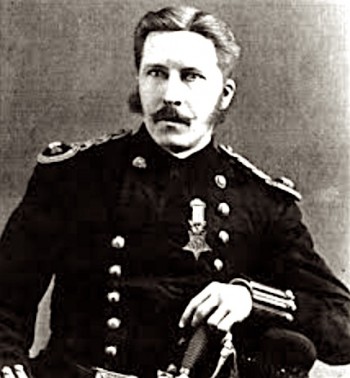
GARDINER (or GARDNER), ASA BIRD (1840-1919). Captain by brevet; captain, 22nd Regiment, New York State National Guard, Company I; first lieutenant, 31st New York Infantry, Company H; 7th Veteran Reserve Corps. A native New Yorker, he was born “Asa Bird Gardner” in Fraunces Tavern where his father kept bar. He graduated from the College of the City of New York in 1859 and New York University School of Law in 1860, practicing briefly before the Civil War.
At the onset of the War, he enlisted at New York City as a first lieutenant on May 21, 1861, and was commissioned into the 31st New York six days later, serving with that regiment until he resigned on August 7. During that tour of duty, Colonel Calvin E. Pratt, commanding officer of the 31st, wrote from Alexandria, Virginia, on July 22, 1861, commending Gardiner for his “coolness and judgment” the previous day at the Battle of First Bull Run, Virginia. He re-enlisted on May 31, 1862, was commissioned into the 22nd as a captain when the regiment was activated for three months, and mustered out at New York City on September 5. He returned to the same regiment and company in 1863, serving for 30 days from June 18 through July 24, before mustering out at New York City. During that enlistment, he was wounded on July 1, 1863, at Carlisle, Pennsylvania. On February 11, 1865, he was commissioned a first lieutenant and joined the 7th Veteran Reserve Corps where he was brevetted to captain on March 13, 1865, “for gallant and meritorious services during the War.”
After mustering out on August 13, 1866, Gardiner returned to serve his country in the United States Army as a judge advocate from July 20, 1866 through December 8, 1888. He served as an aide-de-camp to Secretary of War William Belknap from October 4, 1872 until August 19, 1873, at which time he achieved the rank of major. From 1874 to 1878, he was a professor of law at the United States Military Academy at West Point, where he introduced study of the Lieber Code (used during the Civil War to regulate military conduct). As judge advocate, he was called upon to represent the Army and Navy in civil cases affecting the War and Navy Departments. In 1875, he was selected to be the presiding judge in the Whiskey Ring court-martial of President Ulysses S. Grant’s personal friend, Orville Babcock, but the case was eventually dismissed because of a lack of evidence. He won several cases that he argued before the United States Supreme Court.
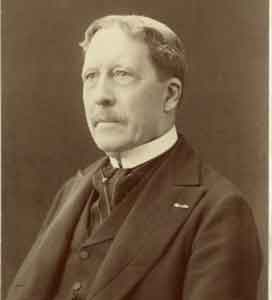
In 1878 through 1879, Gardiner presented the government’s case against General Fitz John Porter (see), a court-martial that was mired in controversy and politics but was ultimately decided in Porter’s favor in 1886. In 1880, he was counsel to Lieutenant General Philip H. Sheridan in a case that investigated Sheridan’s relieving General Gouveneur K. Warren of his command during the Battle of Five Forks, Virginia. Also in 1880, was his most notorious case, the court-martial of Johnson C. Whittaker, one of the first African-American cadets at West Point. Whittaker was charged with faking his claim that three white classmates attacked him. Gardiner secured his conviction leading to Whittaker’s expulsion from the Military Academy. In 1883, the judgment was overturned for faulty evidence but was immediately reinstated on other grounds. (Ultimately, President William Clinton, acting on a request from Congress, posthumously granted Whittaker a commission as a second lieutenant in 1995.)
On July 11, 1884, he officially changed his name to Asa Bird Gardiner adding an “i” to Gardner. Subsequent to his position of judge advocate, he served as President Cleveland’s Acting Assistant Secretary of War 1887-1888, retiring on December 8, 1888, for disability in the line of duty. He was then District Attorney of New York County from 1897 to 1900. He refused to prosecute Tammany Hall bosses, supposedly saying “Reform be damned!” and ultimately was removed from office by Governor Theodore Roosevelt in 1900 after being acquitted of corruption. His cronies at Tammany Hall made him a sachem (high official) in 1901.
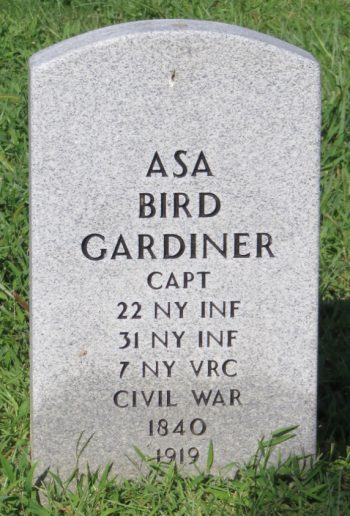
Controversy also surrounded Gardiner’s Medal of Honor which was awarded to him on September 23, 1872, for “distinguished service during the War while serving as captain of the 22nd New York State Militia.” In addition, credit was given “for conspicuous bravery and distinguished conduct during the Gettysburg campaign, particularly in the action of Sporting Hill, Pa., June 30, 1863, and in the defense of Carlisle, Pa., July 1-2, 1863, being wounded at Carlisle.” The award was granted after Gardiner, who was then a lieutenant colonel, asked for the accolade from Secretary of War Belknap. He wrote, “I understand there are a number of bronze medals for distribution to soldiers of the late War, and I request I be allowed one as a souvenir of memorable times past.” At the time that Gardiner was awarded the Medal of Honor, he also was brevetted major general of the military forces of the State of New York under concurrent resolution of the Legislature “for gallant conduct in Gettysburg campaign and gallant and meritorious services during the war.” However, his Medal of Honor was revoked, along with 900 others, as frivolous, in the so-called “Purge of 1917” after a Congressional committee headed by Lieutenant General Nelson A. Miles determined that honorees had to show gallantry on the battlefield. Gardiner, however, refused to return the medal despite a directive from Secretary of War Nelson D. Baker citing that the decision was “a scandalous act” and that it had been in his possession for more than 45 years and was rightfully his.
From 1899 to 1919, Gardiner served as secretary-general of the Society of the Cincinnati, an elite organization whose membership is composed of descendants of officers who served in the Continental Army. Among the other military societies to which he belonged were the Loyal Legion, the Sons of the Revolution, the Military Society of the War of 1812 in which he became commandant with the rank of colonel in 1908, and the Veteran Corps of Artillery of the State of New York. He last resided in Suffern, New York. Harriet Gardiner applied for and received a widow’s pension in 1919, certificate A-8-12-26. Section 13, lot 9194.
GARDINER, ETIENNE VERON (1839-1922). Private, 7th Regiment, New York State Militia, Company E. A native of New York City, Gardiner first served as a private with the 7th Regiment, New York State Militia, for 30 days in 1861. He re-enlisted as a private at New York City in May 1862 and served with the same company and regiment, now part of the New York State National Guard, and mustered out with his company three months later in September.
As per the New York City Directory of 1886 and the census of 1900, Gardiner worked as a clerk. In 1904, he applied for and received a pension, certificate 1,100,645. As per the Connecticut Military Census of 1917, he was 5’11” tall, 180 pounds, retired and disabled with a broken leg. His answers to that questionnaire, issued to determine skills for men who might be called to serve in World War I, indicated that he could not ride a horse, drive a car, swim well or had familiarity with the technology of the time. His last address was in Middletown, Connecticut. Section 42, lot 885.
GARDINER, HENRY D. (1830-1866). Major and judge advocate, United States Volunteers, Judge Advocate’s Department. After enlisting as a major on June 19, 1863, Gardiner, a New Yorker by birth, was immediately commissioned and promoted to major and judge advocate for New York Volunteers in the Judge Advocate’s Department of the United States Volunteers. During this time, he served on the staff of Brigadier General Charles Yates of the Second Brigade at Fenwick, Pennsylvania, as a quartermaster. He last lived on Baltic Street in Brooklyn. Section 152, lot 17280.
GARDNER, THEODORE H. (1844-1864). Private, 37th New Jersey Infantry, Company G. Born in Brooklyn, he mustered into Company G of the 37th New Jersey on June 23, 1864. He died of a gunshot wound while on picket duty at Petersburg, Virginia, on September 5, 1864. His obituary in the Rahway (New Jersey) Register on September 9, 1874, shed light on this young man:
We have received a letter from Lieutenant Jonathan T. Crane (100 day volunteer), now opposite Petersburg, and from him we learn that on Monday last, while one of his men was on duty, he was fired at by a rebel sharp-shooter, the ball hitting him in the forehead and passing right through his head, killing him instantly. The name of the young man is Theodore H. Gardner, son of the late Matthew Gardner, of Brooklyn. Previous to the time of joining Lieutenant Crane’s company he had been employed in this office as a compositor, and during the time he remained in it he conducted himself in a manner which won for him the respect and esteem of his employer and those with whom he had been acquainted. He was a fine young man, rather good looking, and about twenty-one years of age. His loss will be severely felt by his surviving parent and friends.
Gardner was interred at Green-Wood on October 23, 1864. Section 79, lot 10929.
GARNETT, ROBERT SELDEN (1819-1861). General, Confederate States of America. Born in Champlain, Virginia, his family was prominent in intellectual and political circles. Slightly built, he was 5′ 8″ tall with a high forehead, coal black hair and eyes, and was “aristocratic in demeanor.” Garnett graduated from the United States Military Academy in 1841 (number 29 in his class), taught tactics there, served in various Army posts thereafter including aide-de-camp to General Wood and General Zachary Taylor, and distinguished himself during the Mexican War at the Battles of Monterey and Buena Vista. He was promoted to first lieutenant on August 18, 1846, and brevetted to captain for his action at Monterrey and to major for his participation at Buena Vista. On March 9, 1851, he was commissioned captain. From 1852 to 1854, he was commandant of the corps of cadets and instructor in infantry tactics at West Point. He then served on the West Coast where he was promoted to major on March 27, 1855, and designed the seal of the new state of California.
When word reached him in Europe that the Civil War had started, Garnett resigned his commission and returned to his native Virginia to organize Confederate troops. Joining the staff of Robert E. Lee in April 1861, Garnett oversaw the details needed to mobilize Virginia’s citizenry. In June of 1861, he was commissioned brigadier general of the Confederate Army, and given command of forces in the western section of that state. After receiving his command, he said, “They have not given me an adequate force. I can do nothing. They have sent me to my death.” On July 13, 1861, his forces were routed by a body of Union troops six times the size of his command, and he was killed at the Battle of Carrick’s Ford after being struck in the back as he led his rear guard in covering the retreat at Cheat River in western Virginia. At the time he was shot, he was in direct view of Union troops and turned around to see if his men were following him. In an account of that battle by the 14th Ohio troops, Garnett was said to have rallied his men by crying out, “Three cheers for Jeff Davis.” Carrick’s Ford was mired in mud after a summer thunderstorm and the soldiers responded to Union fire in wild confusion.
Garnett gained the distinction of being the first general on either side to fall in battle during the Civil War. After he was mortally wounded, his body fell into the hands of Union forces. At the time his body was found, he wore a colonel’s uniform and a brigadier general’s star. Among his personal possessions were a sword given him by General G. M. Brooke who distinguished himself at the War of 1812, a gold chronometer, and $61 dollars of Virginia currency. Originally interred in a coffin constructed of rough boards, his body was sent to Grafton, Virginia, where a metal coffin could be obtained. His sword, a family heirloom, and other personal effects accompanied his remains. General McClellan had it returned to his family, and he was buried in Baltimore, Maryland. It was not until years later that his body was exhumed by his family and re-interred secretly next to his wife at Green-Wood, on August 28, 1865, because of fear of repercussions from strong anti-Southern feelings. His presence at Green-Wood remained secret until 1959. His cousin, Confederate General Richard Brooke Garnett, died leading his brigade at Gettysburg, Pennsylvania, in Pickett’s Charge. Section 150, lot 11584.
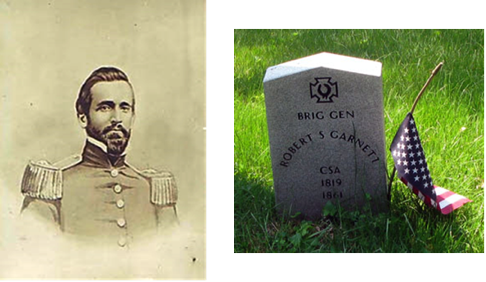


GARRISON, CORNELIUS KINGSLAND (1809-1885). Shipbuilder and businessman. Garrison, who was born in Fort Montgomery (Orange County), New York, studied architecture and civil engineering while working on his father’s schooner. After graduation from college, he moved to Buffalo, New York, where he worked as a builder in 1830. Four years later, he moved to Canada where he built bridges and marine projects for the Canadian government. In 1839, he relocated to St. Louis, Missouri, and made his fortune building and commanding boats on the Mississippi River. He then moved for a short time to Panama working there as an agent of the Nicaragua Steamship Company. When he returned to the United States, he started a banking company known as Garrison, Fritz & Ralston.
In 1852, he settled in San Francisco, California, first associated with the aforementioned steamship company and where he was elected the city’s 5th mayor that same year. As mayor from October 1853 to October 1854, he started many reform projects in the areas of criminal justice, civil management, and civil engineering, some of which are still visible today. According to his obituary in The New York Times, he donated his salary to charity, expanded public schools in part with his own money, and sought to eliminate gambling enterprises. As mayor, he completed the installation of telegraph lines, increased the budget for fire-houses, and regulated carriage fares. He lost his re-election bid to Stephen P. Webb who won by 539 votes.
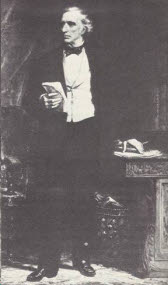
In 1859, he returned to New York City embarking on a career as a financier and speculator. In 1861, at the onset of the Civil War, Garrison, who was fiercely loyal to the Union, allowed the United States government to use most of his ships on the Mississippi River and along the California coast. After the War, he invested in the Pacific Mail Steamship Company and the Missouri Pacific Railroad becoming its president. As a result of a lawsuit that he lost to Cornelius Vanderbilt, the railroad and steamship company were reorganized. Garrison played a large part in establishing gas companies in Chicago and Baltimore. At the end of his life, he lost a considerable amount of his wealth. His last residence was 40 Park Avenue in Manhattan. His death was attributed to “senile debility.” Section 28, lot 13628.
GARVIN (or GARWIN), OLIVER C. (1840-1883). Captain, 52nd New York Infantry, Company G; private, 84th Regiment, New York State Militia, Company C. Originally from Long Island, New York, he enlisted at Brooklyn on April 18, 1861, and mustered into the 84th Regiment on May 23. Garvin was discharged for promotion on September 7, 1861, was commissioned on September 19 as a captain in the 52nd New York Infantry, and was discharged on June 24, 1863.
According to the 1879 Brooklyn City Directory, he was employed as a broker at 60 Wall Street in Manhattan. The 1880 census indicated that he was a custom house broker. At the time of his death, Garvin resided in Flatbush, Brooklyn. In 1890, his widow, Caroline Garvin, received a pension, certificate 307,559, as did a minor in 1894, certificate 404,733. Section 166, lot 28510, grave 1.
GASSAWAY, HENRY N. (or M.) (1843-1914). Private, 114th Pennsylvania Infantry, Company F. Gassaway was born in Washington, D.C. He enlisted as a private on August 12, 1862, mustered into Company F of the 114th Pennsylvania Infantry, and mustered out on March 30, 1865. His application for an invalid pension was approved on June 22, 1865, certificate 50,225. On March 30, 1909, Gassaway mustered into the James S. Wadsworth Post #77 of the G.A.R.; he noted in the post’s sketchbook that he lived in Brooklyn and worked for the Bureau of Highways. He last lived at 195 Clermont Avenue in Brooklyn. He died from bronchitis at Kings County Hospital. Section 190, lot 31995.
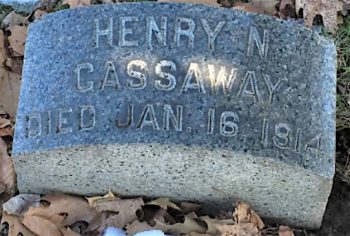
GASSER, MARTIN (1825-1888). Private, 3rd New York Light Artillery, Battery H. A native of Germany, Gasser immigrated to the United States aboard the ship Amelia; he arrived in New York on June 21, 1847. During the Civil War, he enlisted as a private at Lewis, New York, on August 23, 1862, and mustered into the 3rd New York Light Artillery on September 4. As per his muster roll, he was a farmer who was 5′ 5″ tall with blue eyes, brown hair and a dark complexion. He mustered out with his company on June 23, 1865, at Richmond, Virginia.
The 1876 New York City Directory lists him in the beer business. In 1879, he applied for and received an invalid pension, certificate 432,614. He last lived at 615 East 9th Street in Manhattan. His death was attributed to gastritis. Although Philandra Gasser applied for a widow’s pension in 1893, application 580,412, there is no evidence that it was certified. He is interred in the lot owned by the Société Culinaire Philanthropique, which was founded in 1865 by culinary specialists to provide mutual aid and promote interest in French culture and culinary arts. Section 189, lot 18535, grave 51.
GATJEN, CHARLES F. A. (1839-1918). Rank unknown, United States Navy. Born in Bremen, Germany, he came to the United States around 1858. According to his obituary in The New York Times, he served in the Navy during the Civil War but no other details are available. A captain of sailing ships, he circumnavigated the globe numerous times and was one of the officers of the Great Eastern when that vessel took part in laying the first Atlantic cable. He was also involved in laying cable lines between the United States and Siberia. Most of his travel was between the ports of New York, Boston, and South America. After he retired from the sea, he opened the firm of Neike & Gatjen, a shipping crew business in which he was actively employed until 1914. A Freemason, he also belonged to the Odd Fellows. His last residence was at 313 13th Street in Brooklyn. Section 205, lot 30668, grave 2.

GASTON, WILLIAM (1839-1907). Private, 7th Regiment, New York State Militia, Company D. His regiment was one of the first to respond to President Abraham Lincoln’s call to defend Washington, D.C. In civilian life, he was a receiving teller at the Citizens’ Bank at Elizabeth Avenue and Broad Street in Manhattan and then was in the insurance business with his son. As per his obituary in his local newspaper, which confirmed his Civil War service, he was a well-known citizen in the community.
An active member of the Freemasons, Gaston also belonged to the Veterans of the Seventh Regiment; his comrades were invited to attend his funeral. In addition, he was a member of the First Presbyterian Church and, for several years, was a trustee of that church. His last residence was 19 Stiles Street in Elizabeth, New Jersey, where he lived for forty years. His obituary notes that he had been in failing health the last year of his life; after a vacation at his summer home in Lake Champlain, he returned home and died from a brain hemorrhage. Section 52, lot 7972.
GAW (or GOUGH), THOMAS C. (1843-1907). Corporal, 2nd New York Heavy Artillery, Company A. Irish-born Gaw, who used the alias Thomas Gough, enlisted as a private on September 6, 1862, and mustered into the 2nd New York Heavy Artillery that same day. At some point, he was promoted to corporal but was reduced to private on May 1, 1863. On April 2, 1865, he suffered a gunshot wound to the forehead and left leg at Southside Railroad, Virginia, which resulted in rheumatism and lasting head pain. He was discharged on June 6, 1865, at Emory Hospital in Washington, D.C., pursuant to a telegram from the Adjutant General’s Office on May 3, 1865. Emory Hospital, located about a mile east of the Capitol Building, was one of the “barracks” hospitals, facilities that were originally Army barracks but were converted by the government after the troops departed for the battlefront. Gaw’s pension was increased to $24 per month in 1905, certificate 303,360. At that time, he was a lawyer by profession who lived at 6 Grove Street in Manhattan. In 1907, Ellen Gaw was awarded a widow’s pension of $12 per month, certificate 631,119. Section 128, lot 12807, grave 75.
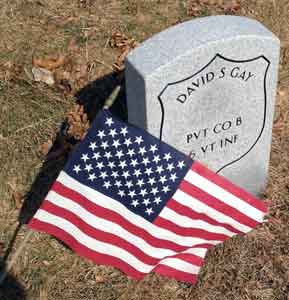
GAY, DAVID S. (1844-1862). Private, 6th Vermont Infantry, Company B. A Vermont native, Gay was living in Chelsea, Vermont, at the time of the 1860 census. He enlisted as a private on September 30, 1861, and mustered into the 6th Vermont on October 15. As per an article on the “Arrival of Sick and Wounded Soldiers” in the New York Tribune on July 14, 1862, Gay’s name is listed as one of the 315 soldiers who arrived from Fortress Monroe, Virginia, aboard the steamer State of Maine the previous day. He was transferred to Long Island College Hospital in Brooklyn where he died from fever (probably typhoid) on July 14, 1862. Interment at Green-Wood was on November 6, 1863. Section 115, lot 13536 (Soldiers’ Lot), grave 78.
GAYLER (or GAYLOR), JAMES (1827-1897). Second lieutenant, 7th Regiment, New York State Militia, Company E. Gayler was born on Rivington Street in New York City, became a post office clerk in 1855, and rose to special agent in 1861. After enlisting as a second lieutenant at New York City on April 17, 1861, he was commissioned into the 7th Regiment on April 26, and mustered out on June 3 at New York City. In civilian life, he was the first assistant to the postmaster of New York City.
According to an article about Gayler’s death in The New York Times, he devised systems for greater efficiency at the Post Office, suggested a successful commemorative stamp for the 1891 World’s Fair held in New York (seeing additional revenue for the stamps in the hands of collectors), and was a renowned handwriting expert who broke many famous cases. He belonged to Lafayette Post #140 of the G.A.R. (which he joined on October 27, 1886) and the Old Guard. Though he was in “bad health” for a year, he continued working until he became seriously ill a week before his death caused by uremia. He last lived at 353 West 57th Street in Manhattan. Section 167, lot 17231, grave 4.
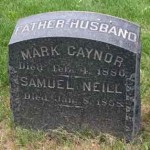
GAYNOR, MARK (1840-1886). Seaman second class, United States Navy. Gaynor enlisted in the United States Navy in 1863 and served as a seaman second class on board the USS North Carolina in the Gulf Squadron. He received a pension from the Navy, certificate 9,082. He last lived at 442 2nd Street in Jersey City, New Jersey. His death was attributed to a skull fracture. Jennie Gaynor applied for and received a widow’s pension in 1892, certificate 12,923. Section A, lot 9146, grave 136.
GAYWOOD, GEORGE (1837-1872). Private, 56th Regiment, New York State National Guard, Company E. After Gaywood enlisted in 1864, he mustered into the 56th New York National Guard for its 100 day activation and mustered out at the end of his enlistment. His last address was in Brooklyn. Section 174, lot 22716.
GEDEICKE, ERNEST (1830-1861). Private, 83rd New York Infantry, Company A. Of German birth, he enlisted at New York City as a private on May 27, 1861, was immediately mustered into the 83rd New York, and was killed by gunshot on July 4, 1861, at Harpers Ferry, Virginia (now West Virginia). He was interred at Green-Wood on July 8. Section B, lot 9895, grave 283.

GEDNEY, GEORGE WASHINGTON (1833-1915). Builder. According to his obituary in The New York Times, Gedney, who was born in Mamaroneck, New York, went to the front in the Civil War along with two of his brothers to erect bridges for Union forces. A builder in South Brooklyn for more than 40 years, he was also a pioneer in the oil fields at Oil City, Pennsylvania, where he constructed derricks for oil wells with four of his brothers. A Brooklyn resident for 68 years and member a Masonic lodge, he last lived at 223 17th Street. He died from arteriosclerosis at the Brooklyn Home for Aged Men. Section 171, lot 12727.
GEER, GEORGE WOLFE (1836-1914). Private, 22nd Regiment, New York State National Guard, Company D. Born in New Baltimore, New York, Geer enlisted and mustered into the 22nd National Guard on May 28, 1862, and mustered out at New York City after three months on September 5. He served again with the 22nd for 30 days in 1863. In 1890, he applied for and received an invalid pension, certificate 785,276. Geer last lived at 72 Union Street in Hempstead, Long Island. His death was caused by uremia and cerebral hemorrhage. His widow, Mary Geer, received a pension in 1914, certificate 779,991. Section 58, lot 4178.
GEERY, JAMES (1842-1867). Private, 6th New York Infantry, Company B; 1st Light Artillery, United States Army, Company A. Originally from Alexandria, Virginia, Geery enlisted as a private at New York City on April 25, 1861, and mustered into the 6th New York five days later. The same day that he was discharged at New York City on November 28, 1862, he re-enlisted and joined the 1st Light Artillery, United States Army. Further details of that enlistment are unknown. His last address was in Poughkeepsie, New York. He died from phthisis. Section 159, lot 14376.
GEIGER, JOHN (1835-1919). Sergeant, 45th New York Infantry, Company K. Of German birth, he enlisted as a private at New York City and mustered into the 45th New York on October 7, 1861. He rose through the ranks becoming a corporal on December 1, 1861, and a sergeant on February 19, 1863. On October 8, 1864, he mustered out at Nashville, Tennessee. His last residence was in Brooklyn. He succumbed to arteriosclerosis. Section A, lot 8100, grave 268.
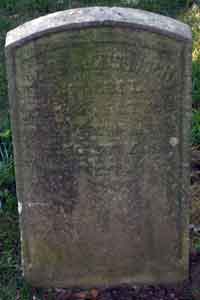
GEISBUESCH (or GEISBUSCH, GEISBUSH), JOHN ANTON (1845-1903). Private, 24th Illinois Infantry, Company E. Of German birth and a resident of Chicago, Geisbuesch enlisted on June 17, 1861, and mustered into the 24th Illinois the next month on July 8. A clerk at the time of his enlistment, he was 5′ 7″ tall with blue eyes, light hair and a ruddy complexion. Listed on the muster rolls as Anton Geisbush, he was taken prisoner at Chickamauga, Georgia, on September 20, 1863, and mustered out on January 7, 1865.
In civilian life, Geisbuesch was in the woolens business. In 1899, he applied for and received an invalid pension, certificate 997,710. His last residence was 353 11th Street in Brooklyn. Originally interred at the United States Crematory in Fresh Pond, Long Island, on March 21, 1903, he was moved to Green-Wood on May 30 of that year. His widow, Martha Geisbuesch, received a pension, certificate 573,605. Section 157, lot 15574, grave 1.
GELSTEN, MARIA ANTOINETTE (1819-1915). Civil War volunteer. Born in New York City, her family owned a farm in Brooklyn on Fifth Avenue and 23rd Street where they lived in the 1840s. As per her obituary in the Brooklyn Daily Eagle, Gelsten always helped others. During the yellow fever epidemic of 1856, she assisted physicians to help those who were afflicted until her family was quarantined. During the Civil War, she received a pass from General Winfield Scott allowing her to deliver goods and supplies to soldiers at Fort Lafayette (near Fort Hamilton in Brooklyn). At the end of her life, she knit wristlets for charity. She last lived in a mansion on Shore Road near Third Avenue in Bay Ridge where her family was prominent in church and social circles. Section 2, lot 7455.
GEORGE, ALEXANDER J. (1840-1899). Private, 5th New York Infantry, Company E. Born in New York City and a driver as per the census of 1860, George enlisted there as a private on April 23, 1861, mustered into the 5th New York on May 9, and mustered out on May 14, 1863, at New York City. The censuses of 1870 and 1880 report that he was employed as a cartman. His last residence was on Garrison Avenue in Jersey City, New Jersey. Section 69, lot 11761, grave 1.
GEORGE, ENOCH B. (1830-1886). Acting second engineer, United States Navy. George was born in New York City. At the time of the 1860 census, he lived in Brooklyn with his wife, Elizabeth, and two young children and was employed as an engineer. On March 10, 1860, he declared his citizenship as a United States-born seaman at New York City; he described himself as 30 years old, 5′ 8″ tall with a dark complexion. His 1863 Draft Registration indicates that he had served at the Navy Yard. George served as an acting second engineer in the Navy from August 18, 1864, until his honorable discharge on September 22, 1865.
On February 17, 1876, George married Sarah Olive Penfield, the widow of Henry Penfield (see). The 1879 and 1884 New York City Directories and the 1880 census list him as an engineer; he then lived at 225 East 110th Street in Harlem. As per his obituary in the New York Herald, he was a member of the Independent Order of Odd Fellows; lodge members were invited to attend his funeral. His death certificate notes that he was married and worked as a bookkeeper. George last resided at 225 East 110th Street in Manhattan. His death was attributed to nephritis.
Sarah George, the executrix of his will, was bequeathed all of his furnishings including plate silver jewelry, wearing apparel, library, ornaments, musical instruments and other articles of household use and personal property. His son, John, was bequeathed $100; his daughter, Rebecca, was given $200; his step-daughter, Frances Penfield Davis, was given $200 and the remainder given to his wife who was free to sell any furnishings as she deemed necessary. After his death, Sarah Olive Penfield George applied for and received a widow’s pension from the Navy, certificate 6,126; it is unusual that Sarah also received a widow’s pension from the Army in 1890 based on her first husband’s service, certificate 331,737. Enoch George, Henry Penfield and Sarah Penfield George are all buried in the same lot; in 1900, Sarah was living with her daughter and son-in-law, Frank H. Adams. Section 3, lot 21025.

GERKEN (or GERCKENS, GERKENS), FREDERICK (or FRITZ) (1842-1927). Gunner’s mate, United States Navy. Gerken was originally from Hamburg, Germany. Borne on the rolls as Fritz Gerckens, he enlisted as a seaman at New York City on February 10, 1862, and served as a gunner’s mate on the USS Monitor, USS Catskill, and USS Princeton, before his discharge on February 16, 1865, at Philadelphia, Pennsylvania.
In 1898, he applied for and received an invalid pension from the Navy, citing rheumatism, piles, defective eyesight and injury to his left index finger, certificate 26,625. At the time he applied for a pension, he was 5′ 10″ tall with blue eyes, brown hair and a fair complexion. Originally paid a pension of $6 per month, his pension was periodically increased, reaching $30 per month in 1916. The 1890 Veterans Schedule confirms his service in the Civil War. A policeman at the Brooklyn Navy Yard, he received an annual annuity of $512.04, payable in monthly installments throughout his lifetime, after he retired in 1920. He last lived at 102 Clinton Street in Hoboken, New Jersey. Section 2, lot 5499, grave 22.
GERKEN, HENRY (1839-1872). First sergeant, 5th Regiment, New York State Militia, Company G. Born in Germany, Gerken enlisted as a first sergeant on May 16, 1861, at Washington, D.C., and mustered that day into Company G of the 5th Regiment, known familiarly as the Jefferson Guard. He mustered out after three months on August 7 at New York City. His last residence was 136 North Oxford Street in Brooklyn. Section 14, lot 6737.
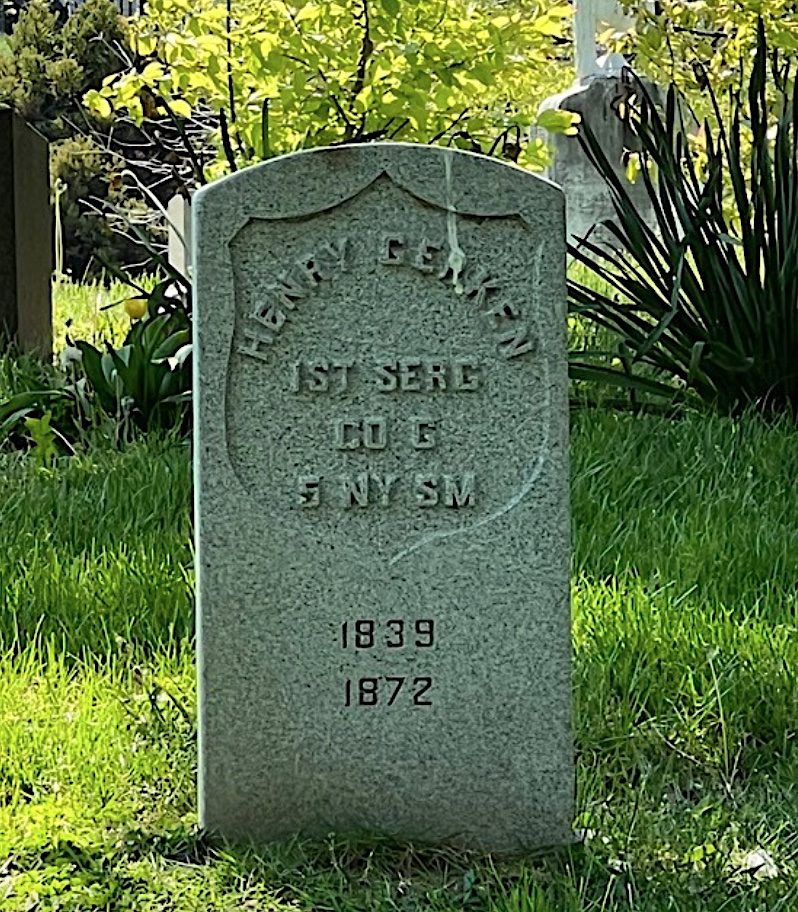
GERMOND, HENRY SHELDON (1834-1920). First sergeant, 22nd Regiment, New York State National Guard, Company E. Serving in 1862, he enlisted at New York City on May 28, mustered into the 22nd on that day, and mustered out on September 5. His obituary, which confirms his service in the Civil War, states that he served with the 7th New York. That service is not noted on his pension index which only mentions service in the 22nd Regiment.
According to the 1880 and 1890 censuses, he was a stockbroker. In 1916, Germond applied for and was granted a pension, certificate 1,165,890. Germond belonged to the Ulysses S. Grant Post #327 of the G.A.R., the Crescent Athletic Club, and the Union League Club. He last resided at 136 Cambridge Place in Brooklyn. He is buried near his brother-in-law Austin Adams (see), who served with the 7th New York in 1863. Section 23, lot 2194.

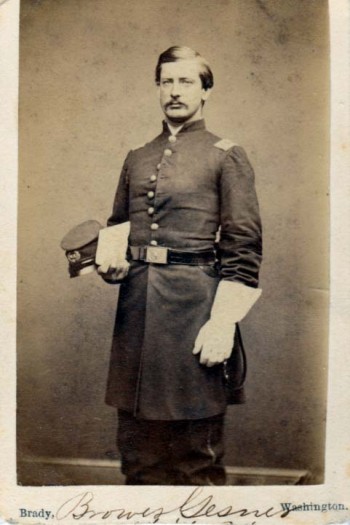
GESNER (or GESSNER), BROWER (1834-1874). Lieutenant colonel by brevet; surgeon and major, 10th New York Infantry; assistant surgeon, 38th New York Infantry. Born in Parrsborough, Nova Scotia, Canada, his father, Dr. A. Gesner, was an eminent chemist and geologist in New York City. Brower Gesner was a graduate of the New York College of Physicians and Surgeons. During the Civil War, he enlisted as an assistant surgeon on September 14, 1861, at Alexandria, Virginia, and was commissioned into the 38th New York’s Field and Staff on that date. As per his obituary in the New York Herald, Dr. Gesner was attached to the Army of the Potomac and “was in the field from the skirmish at Big Bethel down to the decisive battle of Gettysburg.” Colonel J. H. Hobart Ward wrote words of praise for his medical staff from Fair Oaks, Virginia, on June 5, 1862, and singled out Gesner for being “…conspicuous on the battlefield, relieving suffering humanity, our own men and the misguided rebels alike…”
After his discharge on November 14, 1862, Gesner re-enlisted as a surgeon and major at Falmouth, Virginia, on April 9, 1863, and was immediately commissioned into the Field and Staff of the 10th New York. In December 1863, he was the acting medical director, Second Corps, Army of the Potomac. At some point, he was surgeon-in-chief of the artillery of the Second Army Corps; he also served on the staff of General Winfield Scott Hancock. He mustered out on February 9, 1865, at Petersburg, Virginia. Gesner was brevetted lieutenant colonel for “gallant and meritorious services during the War, to date from March 13, 1865.” He was also awarded the Kearny Medal of Honor, a military decoration established during the Civil War which was bestowed on officers who demonstrated valor in face of the enemy.
At the time of Gesner’s death, he was attached to the troops in the Indian Territory where he died at Fort Gibson (now Oklahoma). His obituary noted that his “genial spirit and professional skill” enabled him to make many friends in all walks of life. Section N, lot 20226.
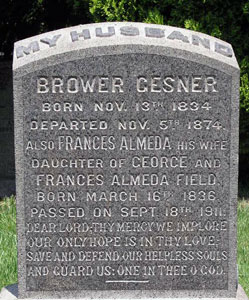
GESSNER, JOSEPH (1823-1901). Musician, 7th Regiment, New York State National Guard, Band. Born in Bavaria, Germany, Gessner enlisted as a musician at New York City on May 25, 1862, mustered into the 7th Regiment’s Band that day, and mustered out three months later on September 5 at New York City. Both the 1878 New York City Directory and the 1880 census list him as a musician. He last lived at 1644 Avenue A in Manhattan. He succumbed to cancer. Section 143, lot 29517, grave 2.
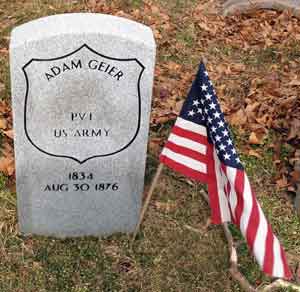
GEYER (or GEIER), ADAM (1844-1876). Private, New York Independent Corps Light Artillery (Enfants Perdus), Company G; 47th New York Infantry, Company H. A native of Germany, he enlisted in the Independent Corps on March 24, 1862, at New York City. He transferred into the 47th on January 30, 1864, and was discharged on May 5, 1865, at Raleigh, North Carolina. He last lived at 130 East 8th Street in New York City. Geyer died of phthisis. Section 115, lot 13536 (Soldiers’ Lot), grave 121.
GIBBENS, FREDERICK HAMMOND (1843-1934). Second lieutenant, United States Army; third lieutenant, United States Revenue Marines. Originally from Boston, Massachusetts, he was appointed third lieutenant in the Revenue Marine Service on October 29, 1862, and resigned his commission on March 2, 1863. He also served as a second lieutenant in the U.S. Army but the details of that service are unknown. In 1866, he spent three years in New York City in the mercantile business and then was employed by The Delaware, Lackawanna and Western Railroad beginning as a transfer clerk and rising to treasurer in 1875 and second vice president from 1882-1886. After retiring in 1899, he moved to Montclair, New Jersey, where he was active in the affairs of Mountainside Hospital, serving as president of the advisory board, and enjoyed painting in water-colors. His last residence was at 77 Upper Mountain Avenue in Montclair. His death was attributed to chronic cardiovascular disease. Section 183, lot 21930.